The Emergence of Gesture
Works on paper – 1944-1959

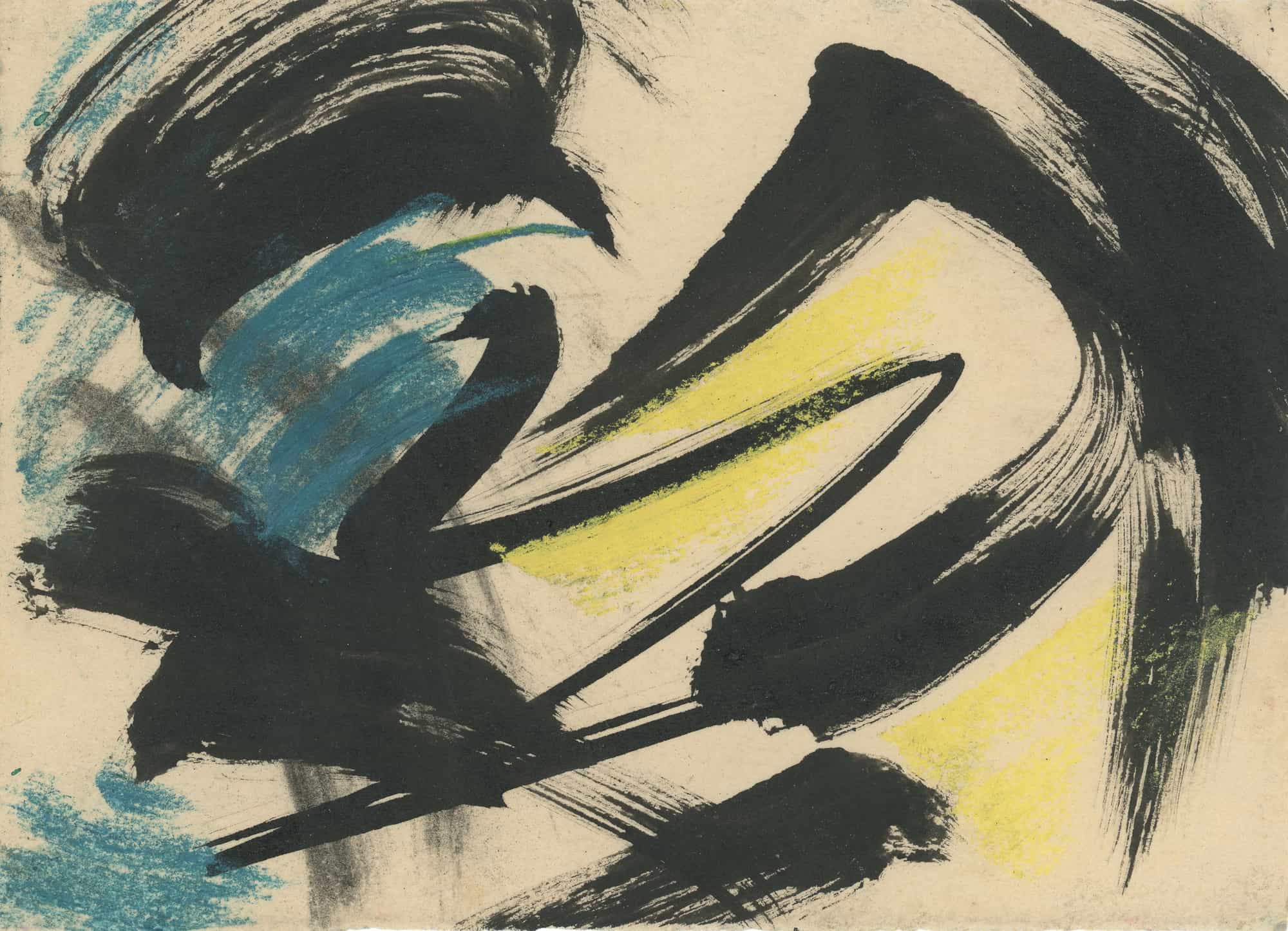
Presented in Brussels at the start of 2020, this group of seminal works by the master of Lyrical Abstraction can now be seen in Paris.
The post-war period formed a crucial juncture in Gérard Schneider’s work, confirming abstraction as the only possible creative path for the artist. Breaking with the pioneers of the abstract movement active in the first half of the 20thcentury, Schneider embraced a new form of abstraction—gestural abstraction. It is the very emergence of gesture in the artist’s works—and the establishment of this creative language—that these works invite the viewer to discover. Slowly, the structures inherited from geometrical traditions appear to fade away, giving way to lyricism.
“Art does not reproduce the visible but makes visible.” It is with this famous phrase that Paul Klee opens a chapter, The Creative Credo, in his book on The Theory of Modern Art. A collection of his writings from the 1920s, this publication establishes the fundamentals of modern art, in particular the theoretical foundations for abstraction in painting. According to Paul Klee, the role of art is not so much to imitate or reproduce nature, but instead to reveal it.
By 1944, Gérard Schneider’s choice had already been made a few years beforehand: abstraction was the path he took to pursue his artistic quest.
During those years marked by the end of global conflict, confronting reality and transcribing it into art was a central issue. What could the subject of art be? If we consider Paul Klee’s point of view again, the work of art extends our perception of the world beyond ourselves. It thus renders the world more visible and can in a way demonstrate the invisible.
Having learned from Cézanne and Kandinsky, and more generally from the avant-garde artists of the first half of the 20th century, Gérard Schneider from then on would tirelessly explore these infinite possibilities that were offered to him. In this fundamental episode of the history of art, his travelling companions were major artists such as Hans Hartung, Pierre Soulages, and Georges Mathieu. This is how at that time in Paris, with these artists who were accompanied by enthusiastic gallerists and art critics, lyrical abstraction was born.
The beautiful and necessary exhibition organized by the Diane de Polignac Gallery will show how important this period was to Schneider’s work; how his aesthetic choices were so full of meaning and the extent to which the work on paper throws an important light on the paintings. It includes over 70 works on paper, most of which have never been seen before, ranging from 1944 to 1959.
These works guide us over a period of fifteen years, alongside Gérard Schneider, in a sort of proximity and intimacy that allow us to glimpse the original mechanics of the creative process. They cover a wide spectrum of the functions of Gérard Schneider’s works on paper. The small format ones – like real miniatures – explore and question the issues raised by classical composition. The absolute freedom with which his work on paper is synonymous can be glimpsed through the variety of supports and techniques.
In larger works, it is the confrontation of the full and the void that culminates with the creation of audacious and radical compositions. From reminiscences of a geometrical analysis of the visual space to the appearance of a clearly calligraphic gesture, this transitional period is illustrated fully and given its rightful place.
It is essential to re-examine this notion of gesture – isn’t it called gestural abstraction elsewhere? – this spontaneous gesture, an eruption that beyond all prior mental construction, has its own existence, its own reality: it is autonomous. In the confrontation with the canvas, a “resistance” of the material can survive, of the constraints that can create a gap between the initial gesture and the finished work. In the case of paper used as a support; the situation is completely different, the gesture is inscribed, raw and untouched, on the sheet. It enables the absence of premeditation that is a foundation of Gérard Schneider’s abstraction.
Very quickly this force and veracity, which working on paper allows, would lead Gérard Schneider to radicalize and simplify his gesture. From the mid-1950s, his inks acquired a truly calligraphic dimension. This free and controlled gesture formed a perfect pendant to his overall process through which he intended to incarnate in the precise instant of painting – the gesture – the invisible reality of emotions and psyche: a true lyric.
A parallel should of course be formed between his personal approach to calligraphy and the enthusiasm with which Schneider’s work was greeted in Japan from this period and the many exchanges with Japanese art critics and calligraphers (ill. 1).
In Gérard Schneider’s practice, the work on paper is not in itself an anticipation of the canvas: it is complementary and parallel to it and does not fit into the same time. The work on paper precedes and succeeds the canvas and is not a “repetition” in any way; rather it is a space – an instant – of freedom that will allow and then echo the confrontation with the canvas. Paper is a permanence in time allowing a group of forms, signs and colored confrontations to be available and in perpetual evolution. The space of the sheet of paper can be considered as the physical space of a laboratory, of this factory for visual elements that comprises the art of Gérard Schneider.
Schneider always knew how important a place this paper support should have in the presentation of his work to the public.
Throughout his career, he chose to conceive exhibitions including or presenting works on paper alone. Although major exhibitions have shown his paintings magnificently (in Brussels in 1953 and in 1962, at the Kootz Gallery New York from 1956 to 19561, in Dusseldorf in 1962 and in Turin in 1970), other exhibitions have specifically highlighted the works on paper: shows at the Galerie Louis Carré in 1951 (with Hans Hartung and André Lanskoy) (ill. 2), at the Galerie de Beaune in 1951 and at the Galerie Im Erker in Saint-Gall in 1961 and 1963 are a few examples.
The final decade of his life should also be mentioned. A decade during which the work on paper took over the larger part of his activity. With the contribution of acrylic paint at the end of the 1960s, color acquired a presence and force that had rarely been equalled before. In addition, the speed of execution that this allowed him enabled the gesture to be completely liberated and it is therefore around the mid-1970s that the production on paper took on a magnitude that had never been known before. The highlight was the start of the 1980s when, retaining the specificities of working on paper, he returned to using large formats, in this way creating rare and intense works (ill. 3).
From the oil on paper paintings of the 1930s (ill. 4) to these large colored compositions, paper was for Gérard Schneider a field of “possibles” that he tirelessly explored with a fire and enthusiasm that were continually renewed.
Christian Demare
October 2020
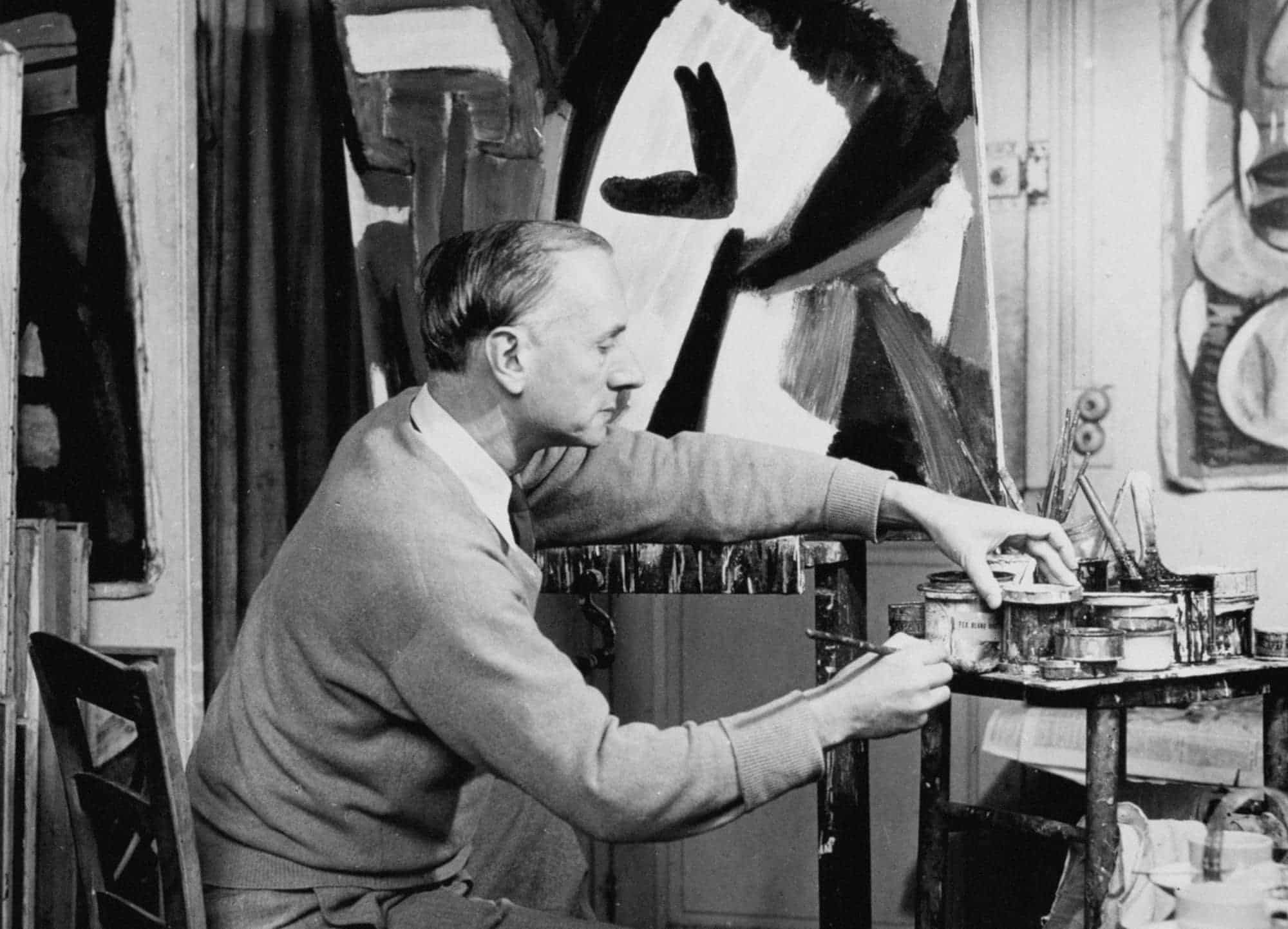
Gérard Schneider in his studio rue Armand-Moisant, Paris, C 1950 – Photograph: Serge Vandercam © Reserved rights / Archives Gérard Schneider
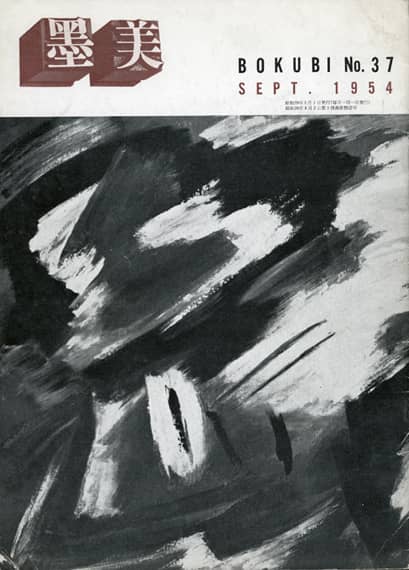

ill. 1 – BOKUBI Magazine, n°37, September 1954. Article by Itsuji Yoshikawa presenting the work of Gérard Schneider. Above: the work reproduced on page 28 – © Archives Gérard Schneider
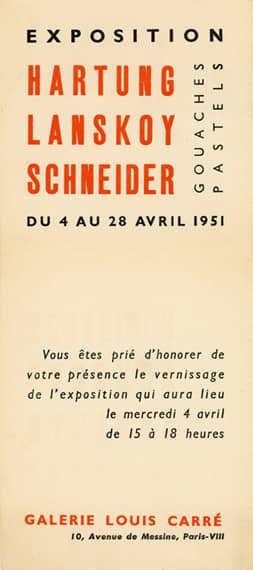
ill. 2 – Invitation to the exhibition “Hartung, Lanskoy, Schneider – gouaches, pastels”, April 1951, Louis Carré Gallery, Paris, France – © Archives Gérard Schneider.

ill. 3 – Untitled, 1983
149 x 107 cm – 48.5 x 42.1 in.
Acrylic on paper
Collection Frac Île-de-France, Paris, France

ill. 4 – Figures dans un jardin, 1934
27 x 35 cm – 10.6 x 13.7 in.
Oil on paper laid on canvas
Private collection, Paris, France

View of the exhibition
Exhibited works

1 – Untitled, 1944
31 x 24 cm / 12 3/16 x 9 7/16 in.
Charcoal and pastel on grey paper
Signed and dated lower right: “Schneider 44”
Referenced on the back

2 – Untitled, 1944
48 x 31,2 cm / 18 7/8 x 12 1/4 in.
Gouache and India ink on paper
Signed and dated lower right: “Schneider 44”
Referenced on the back

3 – Untitled, 1944 ca.
13,3 x 17,4 cm / 5 1/4 x 6 7/8 in.
Brown ink wash on paper
Unsigned and undated. Referenced on the back
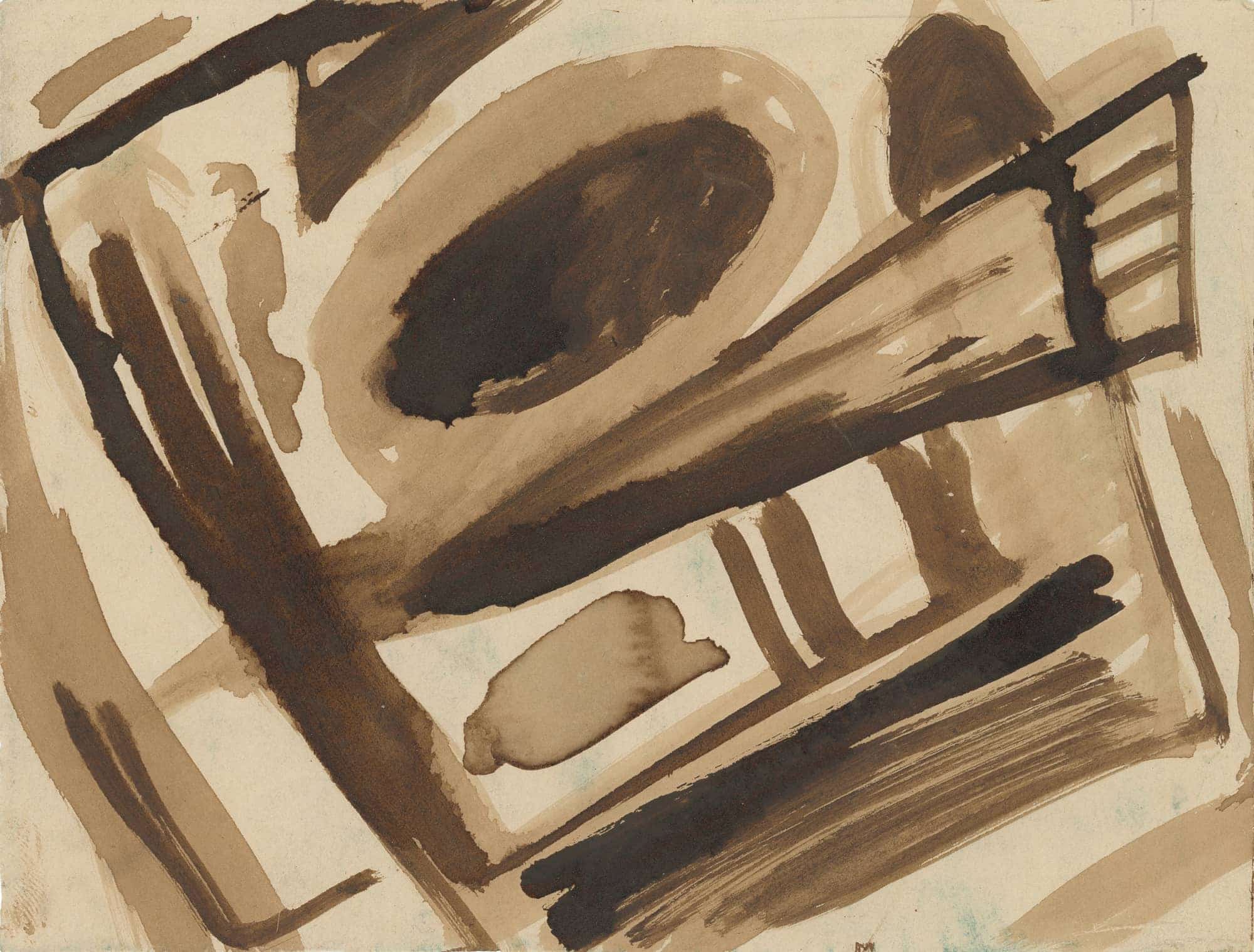
4 – Untitled, 1944 ca.
13,3 x 17,4 cm / 5 1/4 x 6 7/8 in.
Brown ink wash on paper
Unsigned and undated. Referenced on the back

5 – Untitled (double sided artwork), 1945
19,5 x 13,2 cm / 7 11/16 x 5 3/16 in.
India ink on paper
Signed and dated lower left: “Schneider 45”
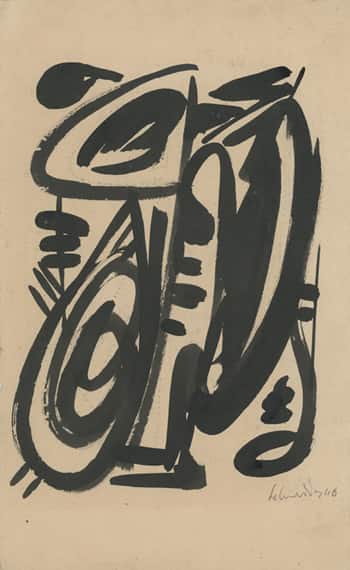
6 – Untitled (double sided artwork), 1946
26 x 16 cm / 10 1/4 x 6 5/16 in.
India ink on paper
Signed and dated lower right: “Schneider 46”.
Signed and dated “Schneider 46” on the back

7 – Untitled, 1946
21,3 x 29,8 cm / 8 3/8 x 11 3/4 in.
Charcoal, India ink and pastel on paper
Signed and dated lower right: “Schneider / -46”
Referenced on the back
Gérard Schneider kept photographic reproductions of his works to annotate them (as shown in the adjacent picture). This work on paper was made in 1947 in Gordes, France, as shown on the back of another photographic print.
These montages and annotations were intended to highlight works that were important to Schneider, or to compare his works to those of other artists through juxtapositions drawing on parallels in form.
In this case, a reference to “Abstrait autonome” [autonomous abstract art] echoes Schneider’s ongoing reflections about his own work. Indeed, as Schneider mentioned in many of his writings, the artist’s primary concern during this period was to achieve absolute autonomy in abstraction—to free his pictorial creations from the influence of reality.
This work on paper can be considered one of the first to achieve such “autonomy”. It was also at this stage of his practice—towards the middle of 1947—that gesture became fully integrated within the artist’s creative process.
One cannot help but notice the correlation between these two key events: the emergence of autonomy in abstraction and the assertion of gesture as a pictorial language in its own right.

Untitled, 1947
Tirage photographique monté sur carton
Photographie : DR © Archives Gérard Schneider / Adagp, Paris

8 – Untitled, 1947
24 x 31 cm / 9 7/16 x 12 3/16 in.
Charcoal, India ink and pastel on paper
Signed and dated lower right: “Schneider 47”. Dedicated “Pour Loïs / 13
mars 1956”. Referenced on the back

9 – Untitled (double sided artwork), 1946
49,5 x 32,4 cm / 19 1/2 x 12 3/4 in.
Charcoal on paper
Signed and dated lower left: “Schneider / 46”

10 – Untitled (double sided artwork), 1946
47,4 x 31,5 cm / 18 11/16 x 12 3/8 in.
Charcoal and pastel on paper
Signed and dated lower right: “Schneider / 46”
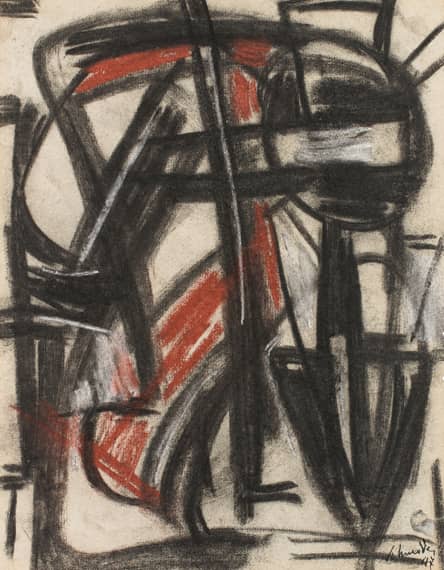
11 – Untitled, 1947
31 x 24 cm / 12 3/16 x 9 7/16 in.
Charcoal and pastel on paper
Signed and dated lower right: “Schneider / 47”
Referenced on the back
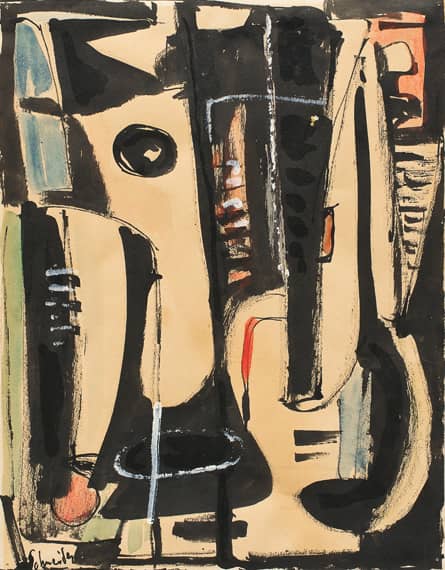
12 – Untitled, 1946 ca.
30 x 23 cm / 11 13/16 x 9 1/16 in.
Gouache and India ink on paper
Signed lower left: “Schneider”

13 – Untitled (double sided artwork), 1947 ca.
35 x 27 cm / 13 3/4 x 10 5/8 in.
Charcoal and pastel on paper
Signed and dated lower right: “Schneider”
Referenced on the back

14 – Untitled, 1947 ca.
33 x 25,5 cm / 13 x 10 1/16 in.
Charcoal and pastel on black paper
Unsigned and undated

15 – Untitled, 1948
48,5 x 63 cm / 19 1/16 x 24 13/16 in.
Charcoal on paper
Signed and dated lower right: “Schneider-48”
Referenced on the back
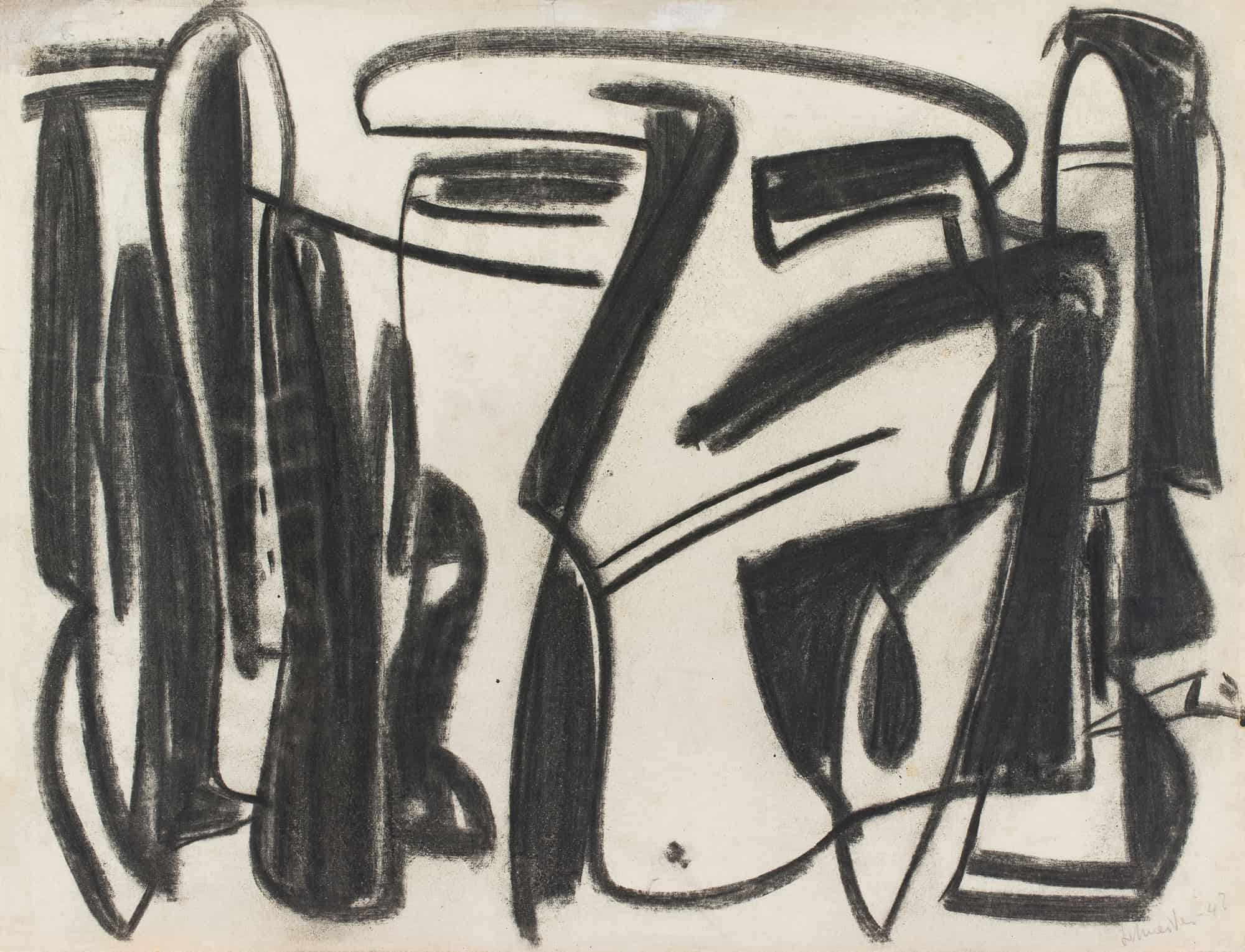
16 – Untitled, 1948
48,5 x 63 cm / 19 1/16 x 24 13/16 in.
Charcoal on paper
Signed and dated lower right: “Schneider – 48”
Referenced on the back
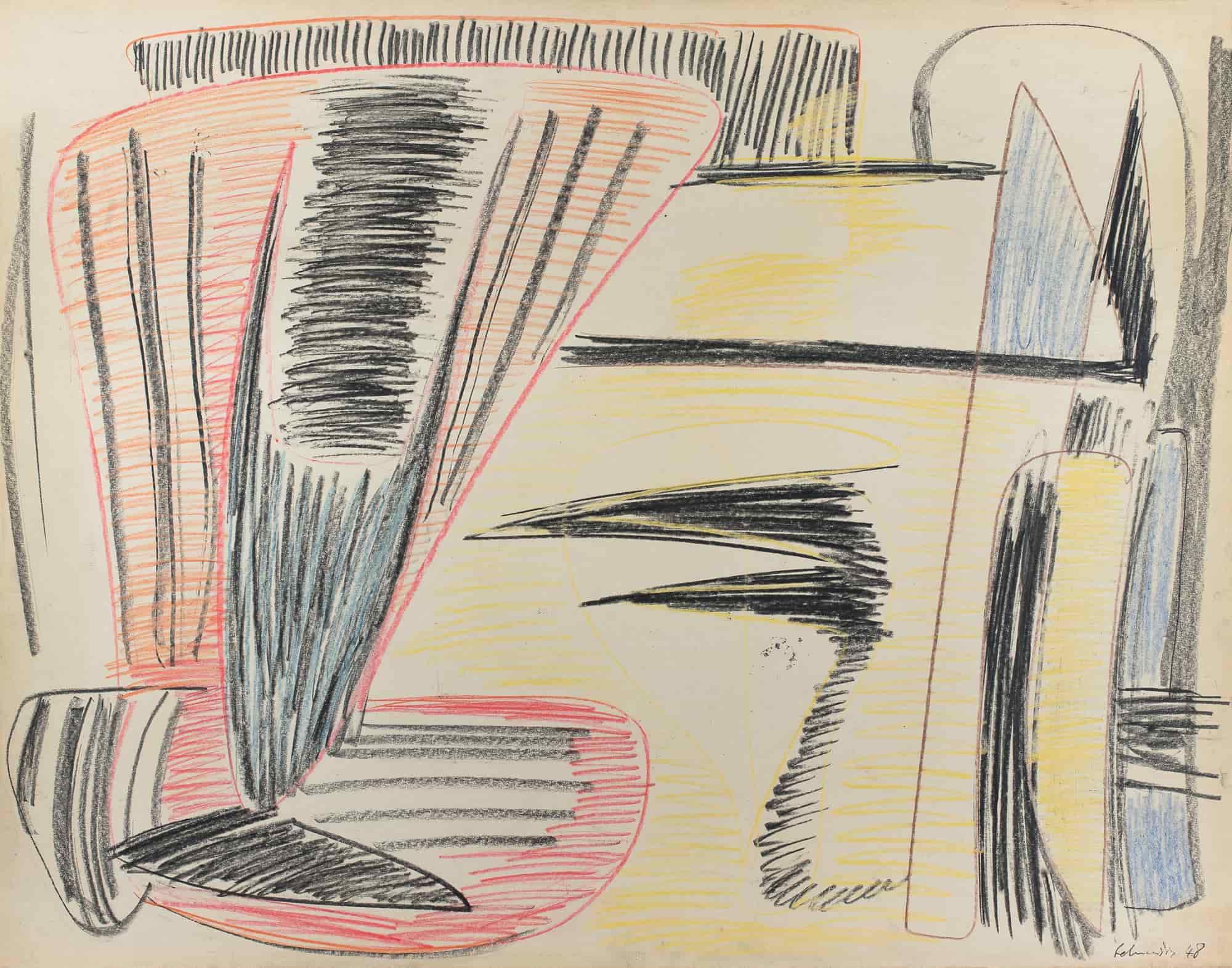
17 – Untitled, 1948
48 x 60,8 cm / 18 7/8 x 23 15/16 in.
Pencil and pastel on paper
Signed and dated lower right: “Schneider 48”
Referenced on the back
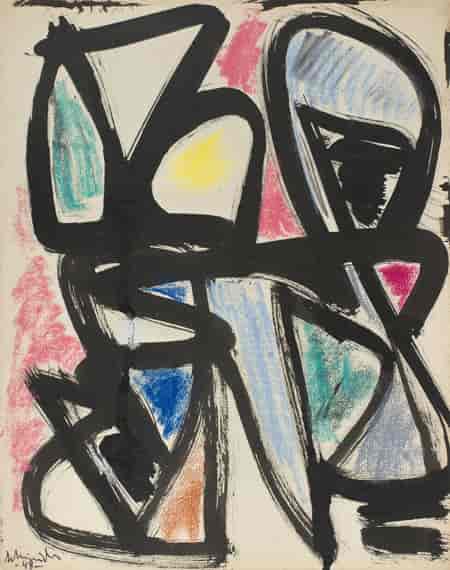
18 – Untitled, 1948
31 x 24 cm / 12 3/16 x 9 7/16 in.
India ink and pastel on paper
Signed and dated lower left: “Schneider / – 48 -”
Referenced on the back

19 – Untitled (double sided artwork), 1948
48 x 62,6 cm / 18 7/8 x 24 5/8 in.
Charcoal and pastel on paper
Signed and dated lower right: “Schneider – 48”
Referenced on the back
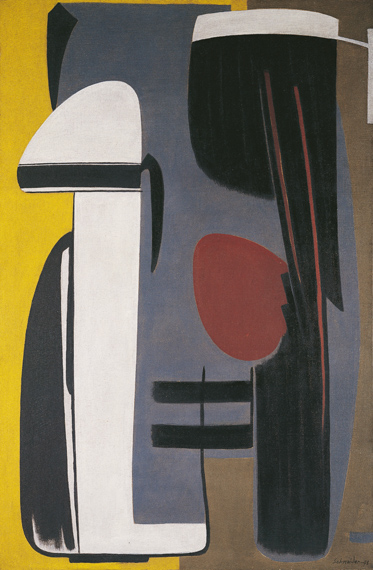
Gérard SCHNEIDER
Opus 360, 1948
147 x 97 cm
Oil on canvas
Fondation Gandur pour l’Art, Genève, Suisse

Gérard SCHNEIDER
Untitled, 1949
100 x 81 cm
Oil on canvas
Musée de Grenoble, Grenoble, France
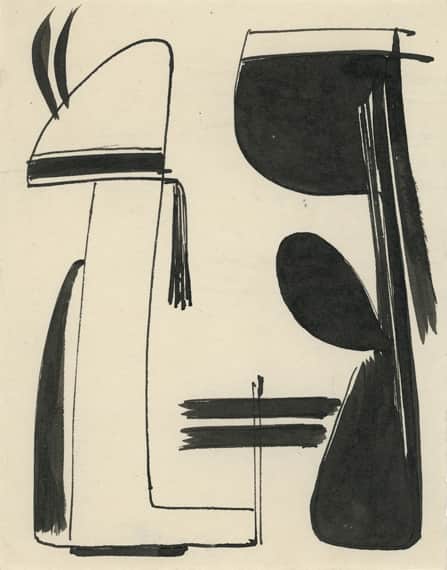
20 – Untitled, 1948 ca.
13,4 x 10,5 cm / 5 1/4 x 4 1/8 in.
India ink on paper
Unsigned and undated. Referenced on the back

21 – Untitled, 1948 ca.
13,4 x 10,5 cm / 5 1/4 x 4 1/8 in.
India ink on paper
Unsigned and undated. Referenced on the back
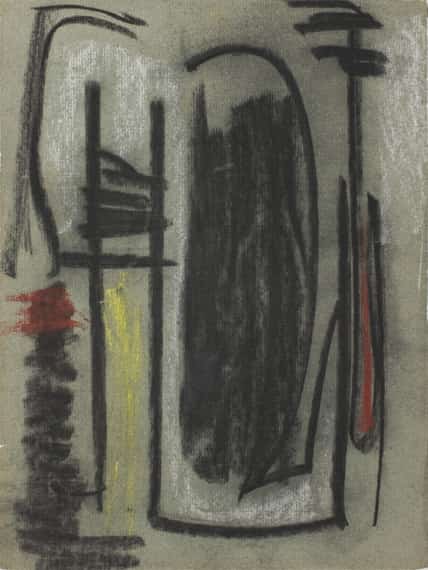
22 – Untitled, 1947 ca.
31,5 x 23,5 cm / 12 3/8 x 9 1/4 in.
Charcoal and pastel on paper

23 – Untitled, 1948 ca.
10,5 x 13,4 cm / 4 1/8 x 5 1/4 in.
India ink on paper
Unsigned and undated. Referenced on the back
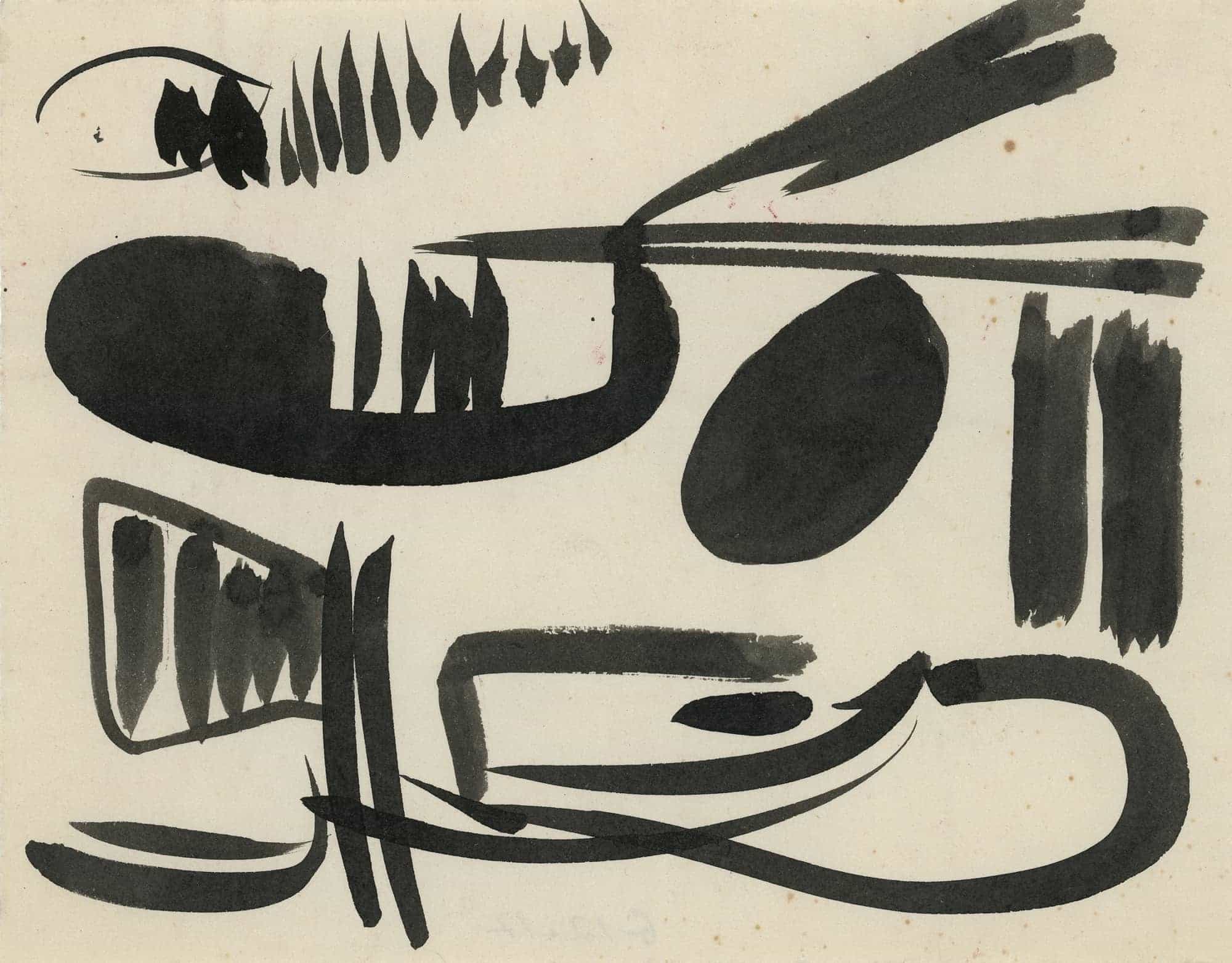
24 – Untitled, 1948 ca.
10,5 x 13,4 cm / 4 1/8 x 5 1/4 in.
India ink on paper
Unsigned and undated. Referenced on the back

25 – Untitled, 1948 ca.
31,5 x 24 cm / 12 3/8 x 9 7/16 in.
Charcoal and pastel on paper
Signed lower right: “Schneider”. Referenced on the back
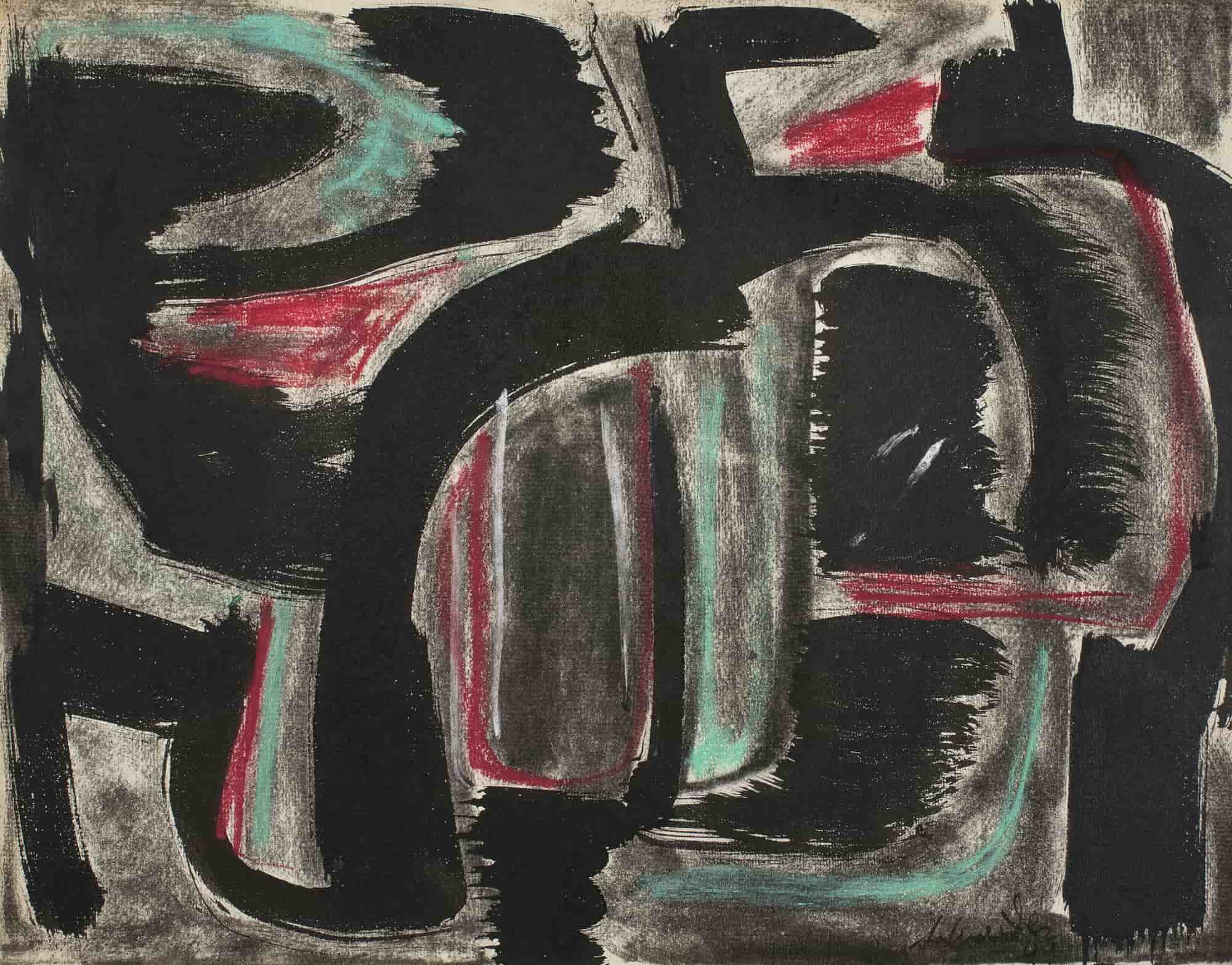
26 – Untitled, 1949
24 x 31 cm / 9 7/16 x 12 3/16 in.
India ink and pastel on paper
Signed and dated lower right: “Schneider / –49”
Referenced on the back
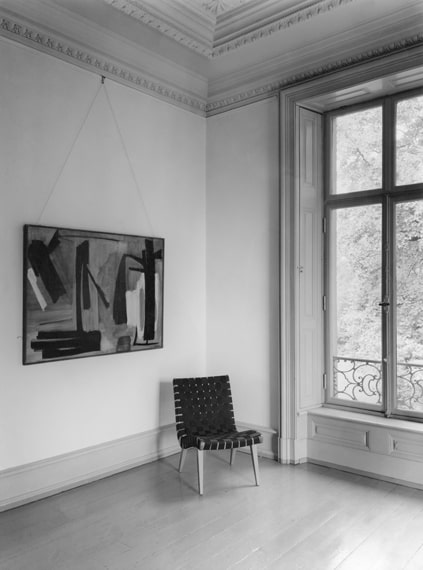
View of the exhibition Gérard Schneider, Otto Stangl Gallery, Munich, Germany, 1952. The work (cat. n°27) reproduced on the next pages was shown at this exhibition – Photograph: Reserved rights © Archives Gérard Schneider

27 – Untitled, 1949
47,3 x 63,3 cm / 18 5/8 x 24 15/16 in.
India ink, oil and pastel on paper
Signed and dated lower right: “Schneider / -49“. Stamp of the Otto
Stangl Gallery and referenced on the back

28 – Untitled, 1949
47,2 x 62,9 cm / 18 9/16 x 24 3/4 in.
Charcoal and pastel on paper
Signed and dated lower right: “Schneider – 49 – 9”
Referenced on the back

29 – Untitled (double sided artwork), 1949
24 x 31,5 cm / 9 7/16 x 12 3/8 in.
Charcoal, gouache and India ink on paper
Signed and dated lower right: “Schneider 49”
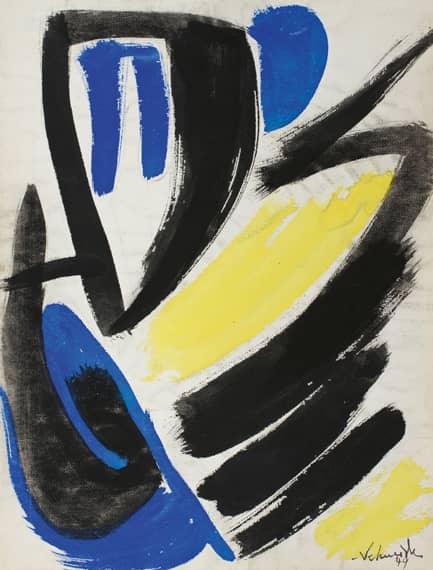
30 – Untitled, 1949
31,5 x 23,7 cm / 12 3/8 x 9 5/16 in.
Gouache on paper
Signed and dated lower right: “Schneider / 49”
Referenced on the back
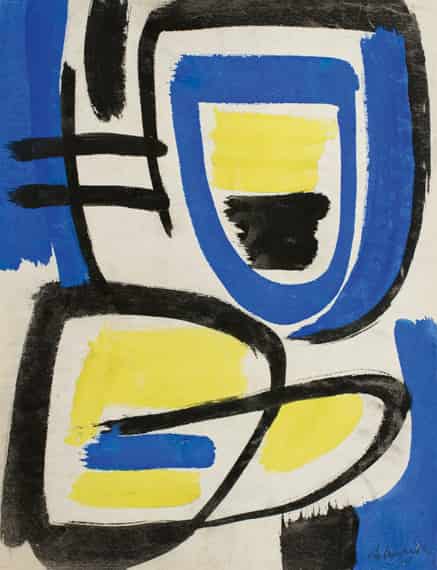
31 – Untitled, 1949
31,5 x 23,7 cm / 12 3/8 x 9 5/16 in.
Gouache on paper
Signed and dated lower right: “Schneider / -49”
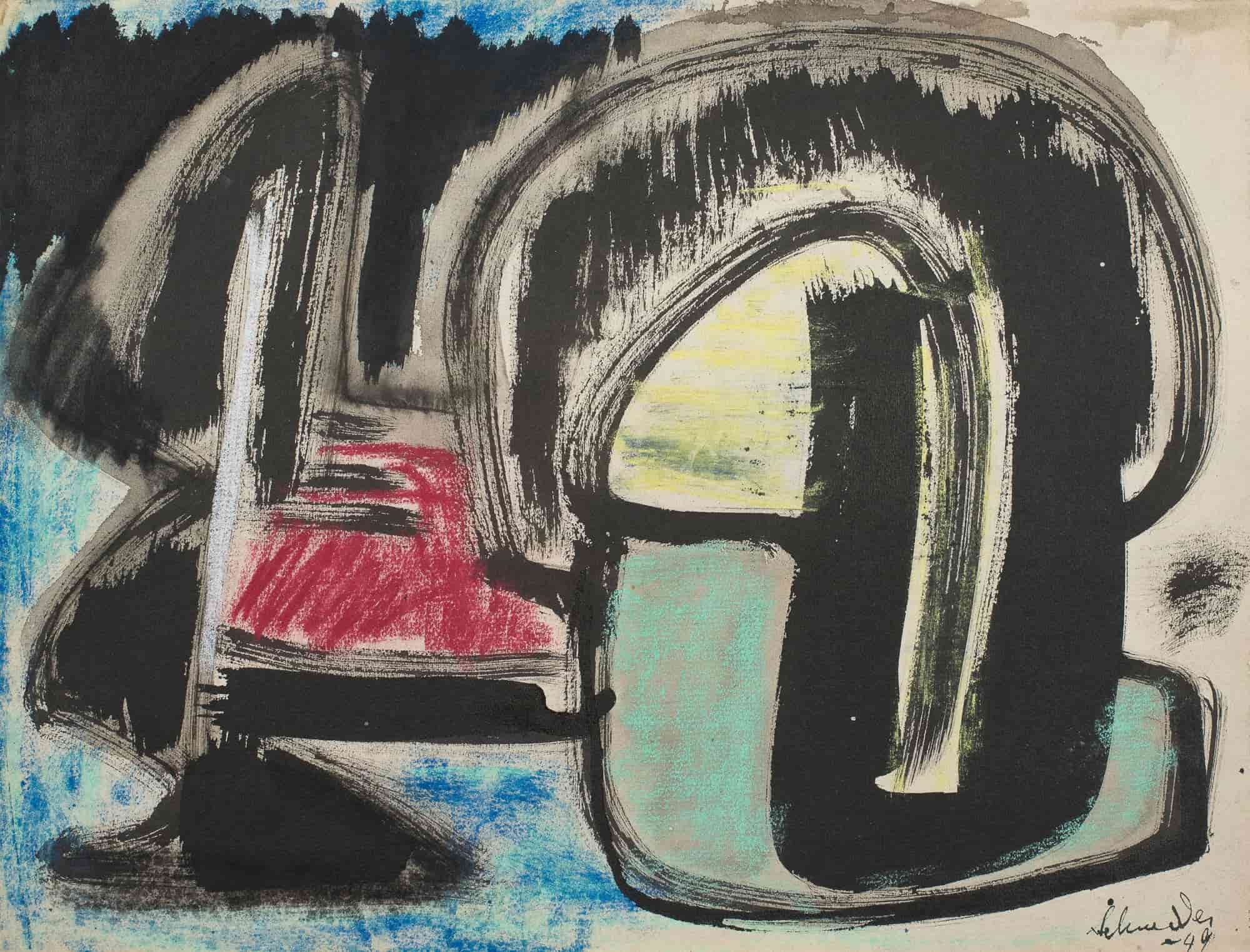
32 – Untitled, 1949
24 x 31 cm / 9 7/16 x 12 3/16 in.
India ink and pastel on paper
Signed and dated lower right: “Schneider / – 49”
Referenced on the back

33 – Untitled, 1949
24 x 31 cm / 9 7/16 x 12 3/16 in.
Charcoal, India ink and pastel on paper
Signed and dated lower right: “Schneider / 49”
Referenced on the back
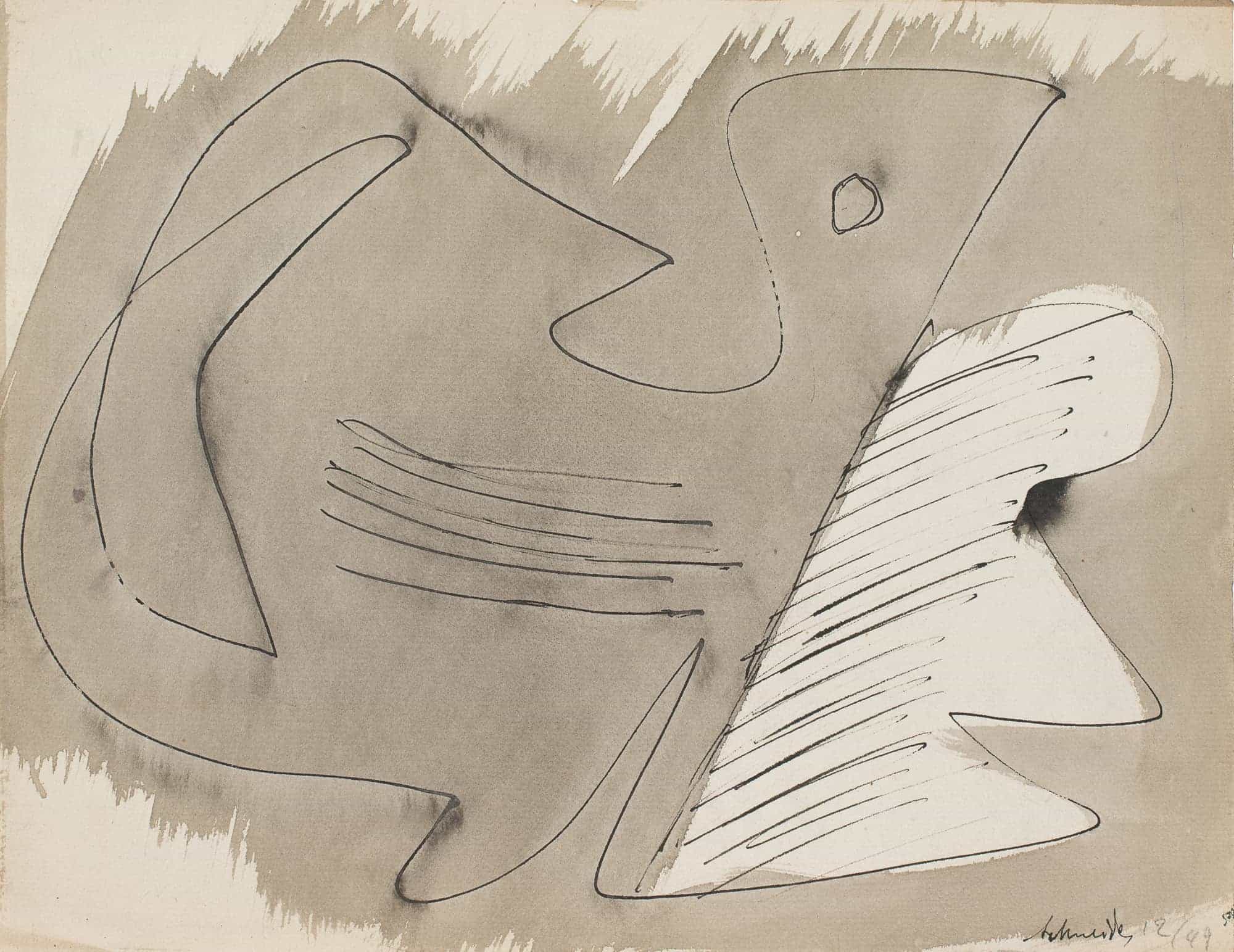
34 – Untitled, 1949
24 x 31 cm / 9 7/16 x 12 3/16 in.
India ink on paper
Signed and dated lower right: “Schneider 12/49”
Referenced on the back
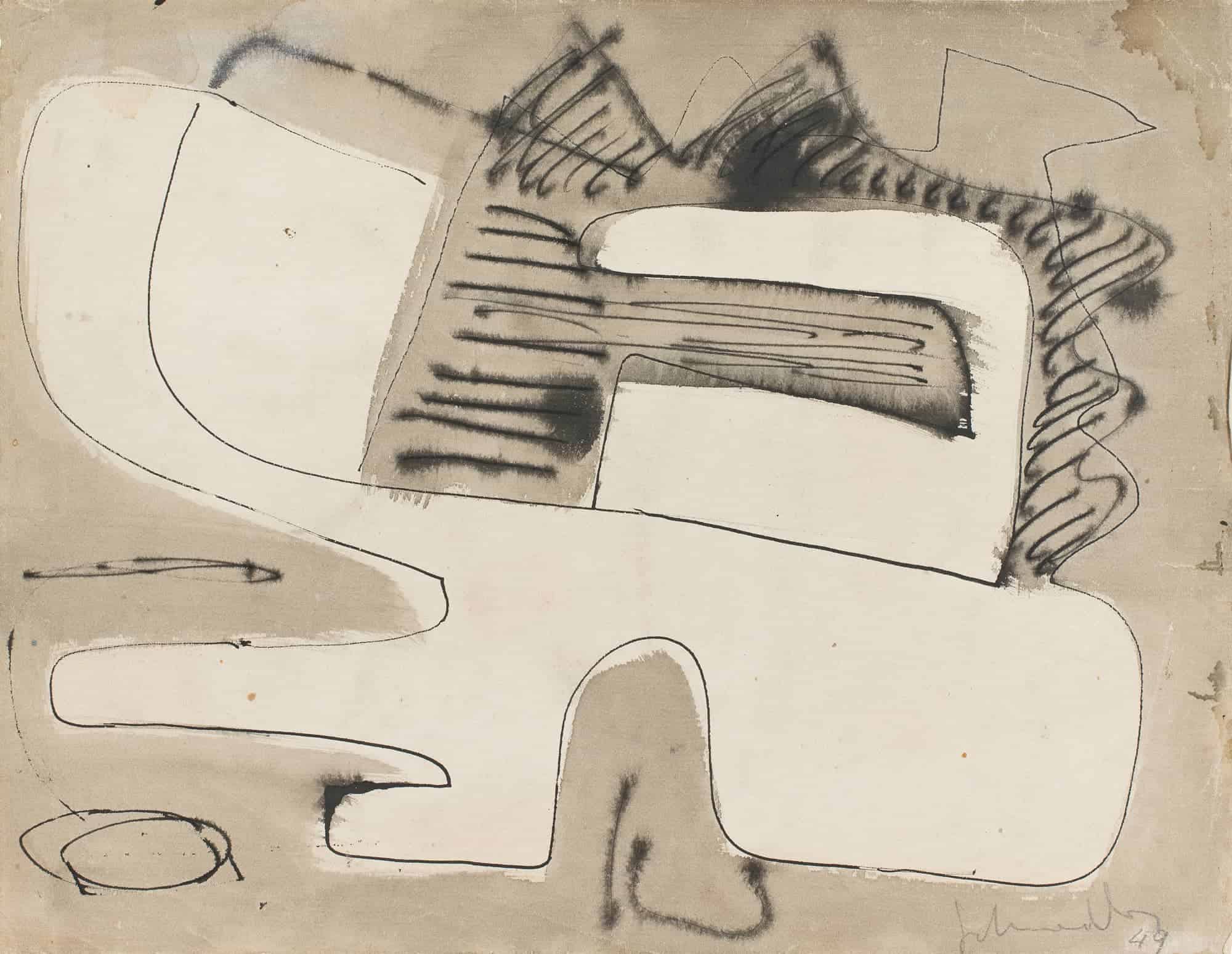
35 – Untitled, 1949
24 x 31 cm / 9 7/16 x 12 3/16 in.
India ink on paper
Signed and dated lower right: “Schneider / 49”
Referenced on the back

Gérard Schneider in Gordes, 1946 – Photograph: Reserved rights
© Archives Gérard Schneider

36 – Untitled, 1949
31 x 24 cm / 12 3/16 x 9 7/16 in.
India ink, charcoal and pastel on paper
Signed and dated lower right: “Schneider / –49”
Referenced on the back

37 – Untitled (double sided artwork), 1949 ca.
33 x 25 cm / 13 x 9 13/16 in.
Charcoal and pastel on paper
Unsigned and undated
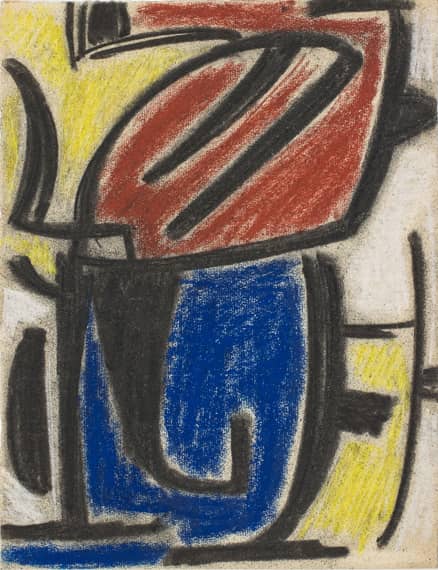
38 – Untitled, 1949 ca.
30,8 x 23,5 cm / 13 x 9 13/16 in.
Charcoal and pastel on paper
Signed lower right: “Schneider”

39 – Untitled, 1949
24 x 31 cm / 9 7/16 x 12 3/16 in.
India ink on paper
Signed and dated lower right: “Schneider / 12-49”
Referenced on the back

40 – Untitled (double sided artwork), 1950
21,8 x 18 cm / 8 9/16 x 7 1/16 in.
Gouache and ink on paper
Signed and dated lower right: “Schneider / -50”
Referenced on the back

41 – Untitled, 1950
19,5 x 18,5 cm / 7 11/16 x 7 1/4 in.
Gouache and ink on paper
Signed and dated lower right: “Schneider 50”
Referenced on the back
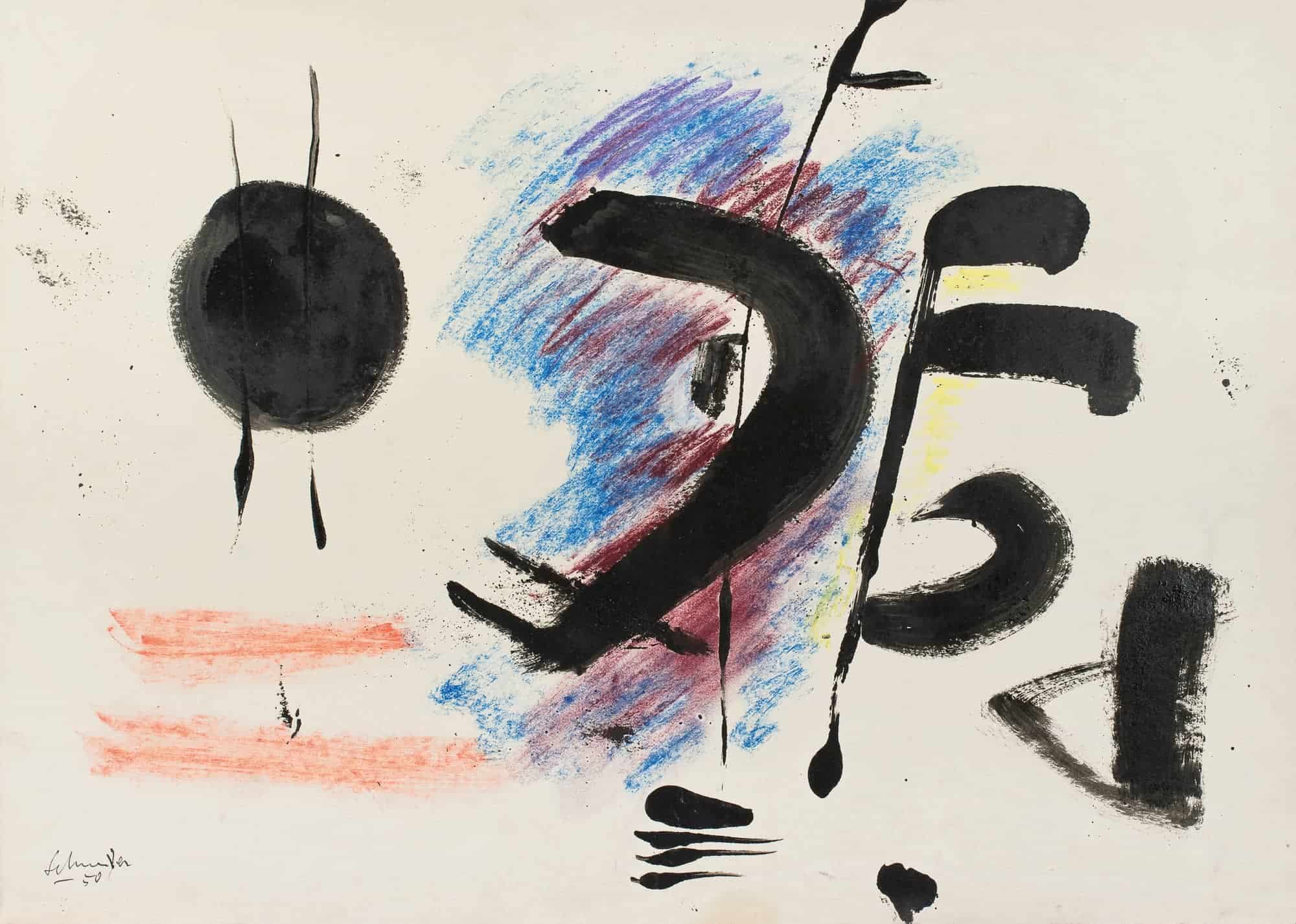
42 – Untitled, 1950
37,5 x 52,5 cm / 14 3/4 x 20 11/16 in.
India ink and pastel on paper
Signed and dated lower left: “Schneider / – 50”
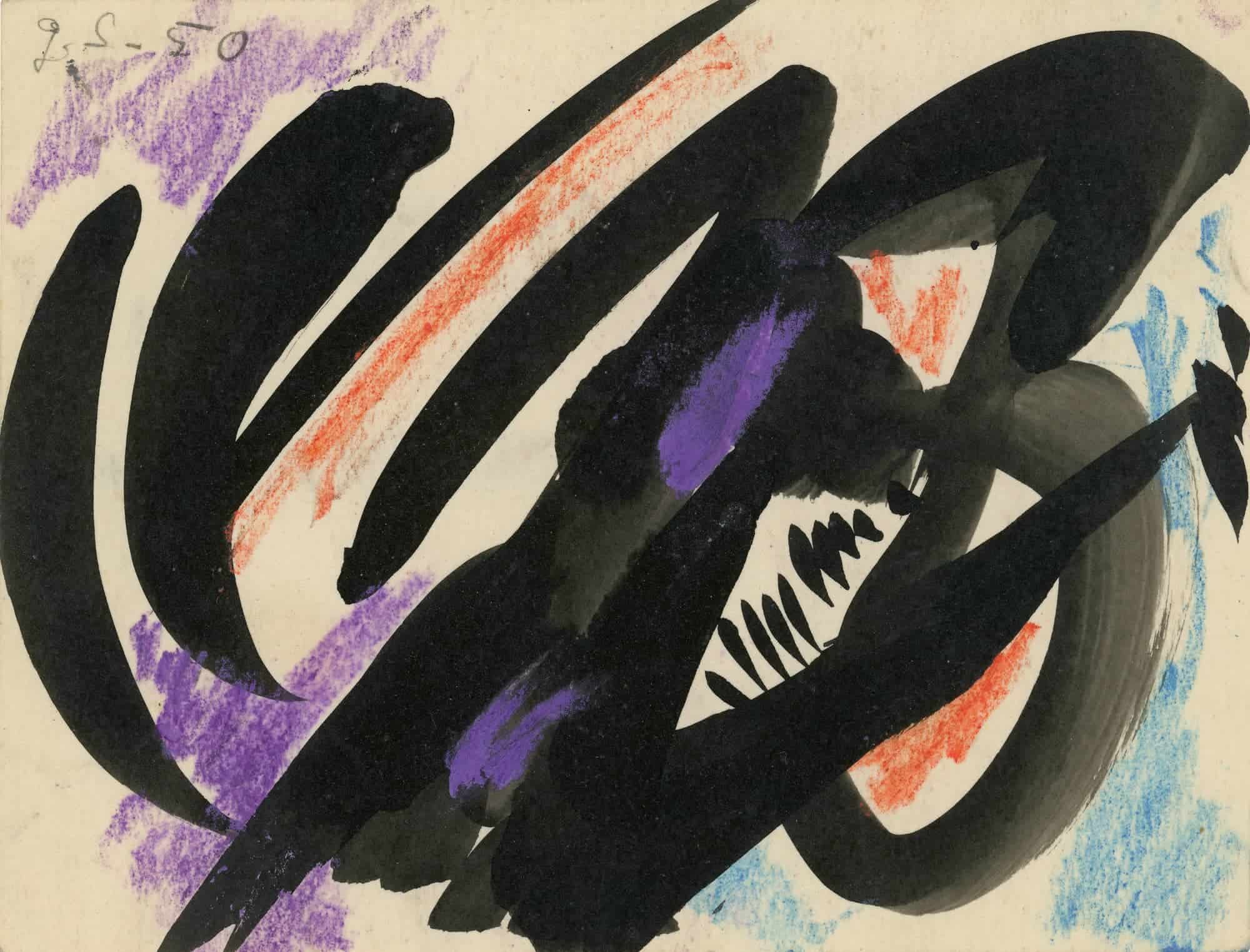
43 – Untitled, 1950
10,4 x 13,6 cm / 4 1/16 x 5 3/8 in.
India ink and pastel on paper
Signed and dated upper left: “gS-50”
Signed and dated “G 12-50” on the back

44 – Untitled (double sided artwork), 1950 ca.
10,4 x 13,4 cm / 4 1/16 x 5 1/4 in.
India ink and pastel on paper
Unsigned and undated. Referenced on the back
LIST of WoRKS88 89
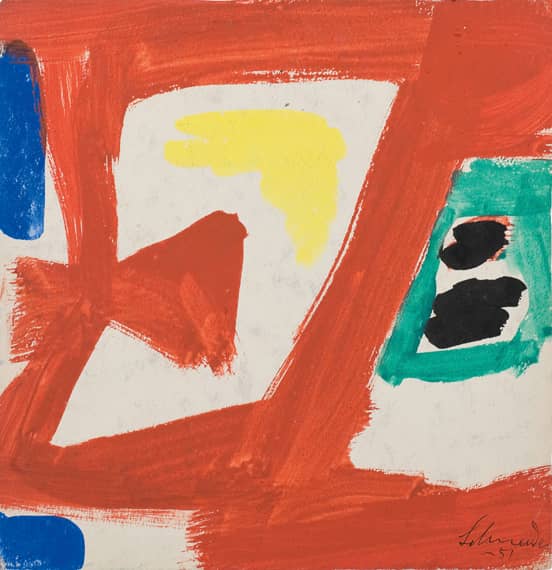
45 – Untitled, 1951
19 x 18,5 cm / 7 1/2 x 7 1/4 in.
Gouache on paper
Signed “Schneider” and dated “51” lower right
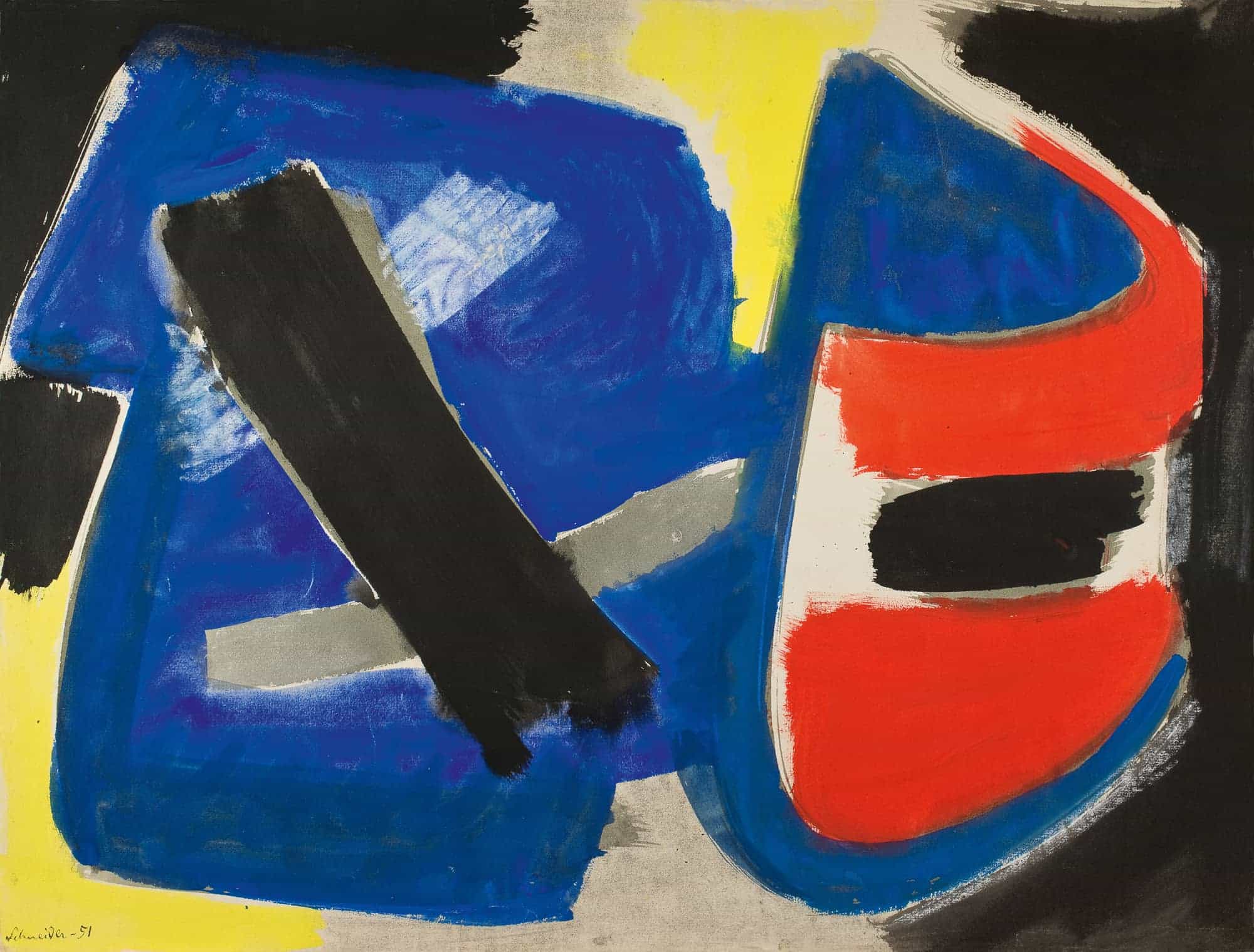
46 – Untitled, 1951
47,5 x 62,9 cm / 18 11/16 x 24 3/4 in.
Gouache, India ink and pastel on paper
Signed and dated lower left: “Schneider – 51”
Referenced on the back

47 – Untitled, 1951
22 x 18 cm / 8 11/16 x 7 1/16 in.
Gouache on paper
Signed and dated lower right: “Schneider / 51”
Referenced on the back

48 – Untitled (double sided artwork), 1951
22 x 18 cm / 8 11/16 x 7 1/16 in.
Gouache an India ink on paper
Signed and dated lower left: “Schneider – 51”
Referenced “P425” lower right. Signed “Schneider” on the back

49 – Untitled, 1951 ca.
10,4 x 9,9 cm / 4 1/16 x 3 7/8 in.
India ink and gouache on paper
Unsigned and undated. Referenced on the back

50 – Untitled (double sided artwork), 1951
17,8 x 21,8 cm / 7 x 8 9/16 in.
Gouache and India ink on paper
Signed and dated lower right: “Schneider / – 51”
Referenced “P465” lower left

51 – Untitled, 1951
22 x 18 cm / 8 11/16 x 7 1/16 in.
Gouache and ink on paper
Signed and dated lower left: “Schneider.51”
Referenced on the back

52 – Untitled, 1951 ca.
9,8 x 12 cm / 3 7/8 x 4 3/4 in.
India ink and pastel on paper
Unsigned and undated. Referenced on the back

53 – Untitled (double sided artwork), 1951
10 x 12 cm / 3 15/16 x 4 3/4 in.
India ink and pastel on paper
Signed and dated lower right: “GS-51”
Referenced on the back
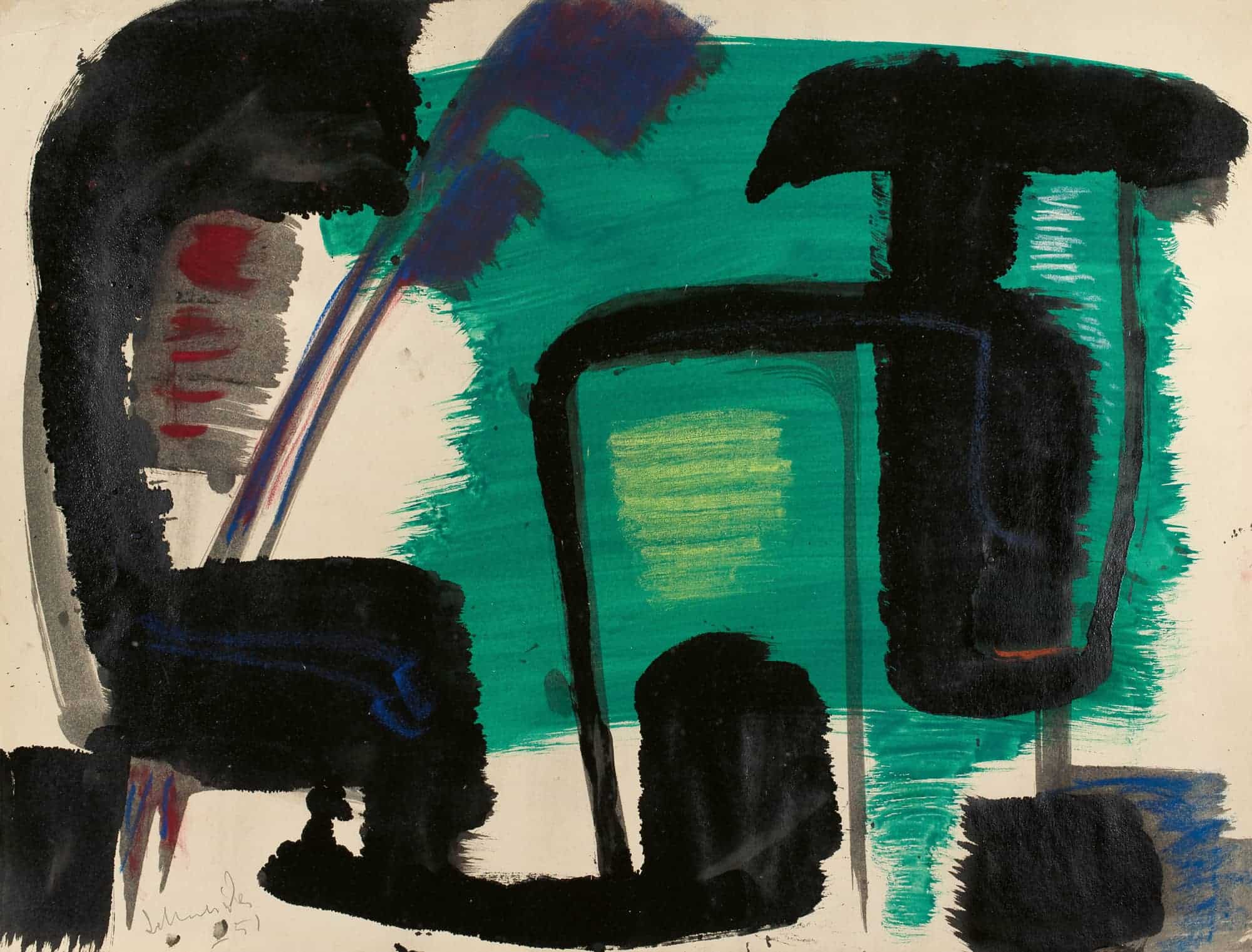
54 – Untitled, 1951
48 x 63 cm / 18 7/8 x 24 13/16 in.
Gouache, India ink and pastel on paper
Signed and dated lower left: “Schneider / -51”
Referenced on the back
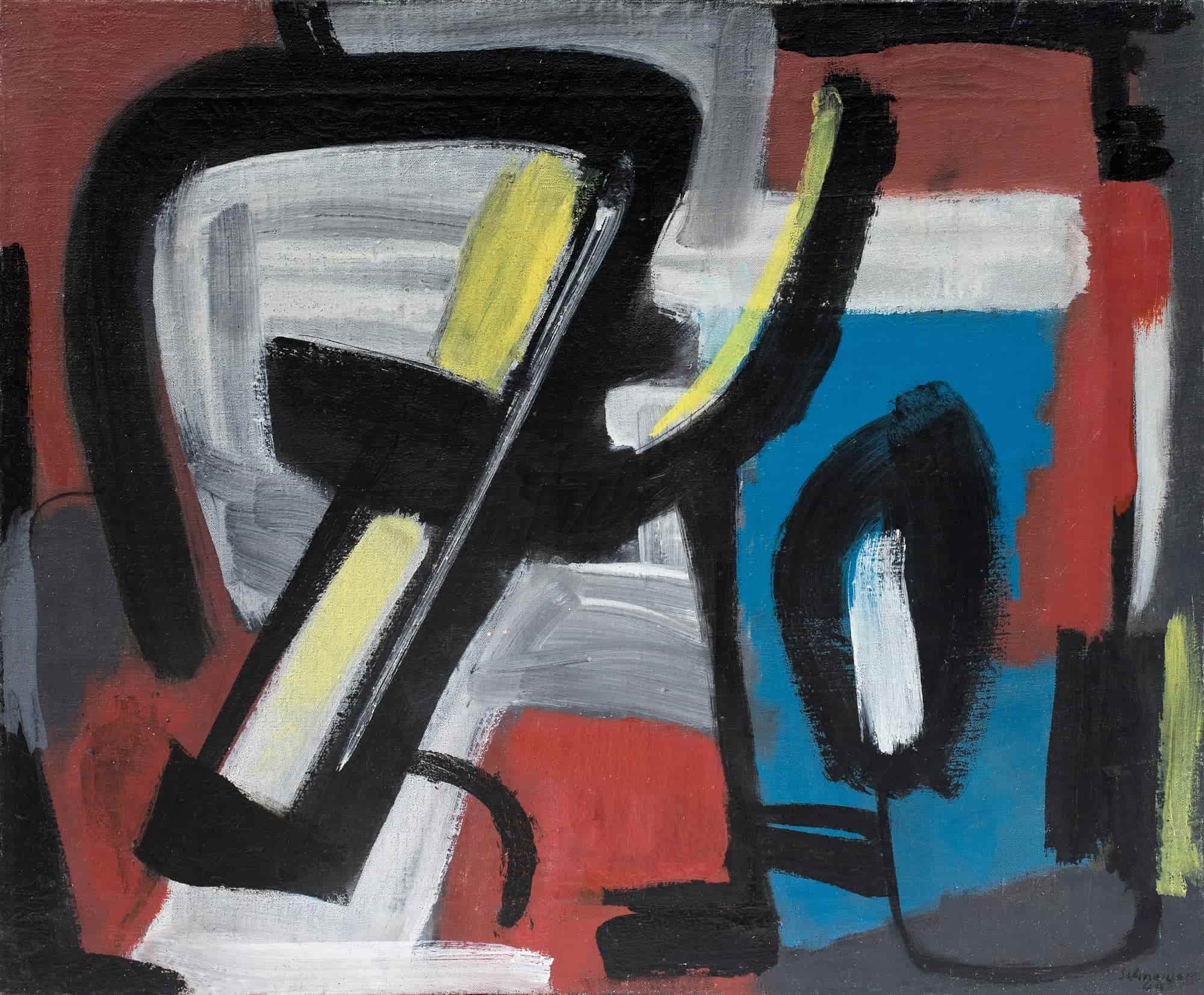
Gérard SCHNEIDER
opus 428, 1949
60 x 73 cm
Oil on canvas
Collection particuière, France

55 – Untitled, 1951
45 x 62,7 cm / 17 3/4 x 24 11/16 in.
Gouache and India ink on paper
Signed and dated lower left: “Schneider / -51”
Referenced on the back

56 – Untitled, 1951
48,1 x 62,3 cm / 18 15/16 x 24 1/2 in.
Gouache and India ink on paper
Signed and dated lower right: “Schneider / 51”
Referenced on the back

57 – Untitled, 1951 ca.
9,2 x 13 cm / 3 5/8 x 5 1/8 in.
India ink and pastel on paper
Unsigned and undated. Referenced on the back

58 – Untitled, 1951 ca.
9,5 x 13 cm / 3 3/4 x 5 1/8 in.
India ink, charcoal and pastel on paper
Unsigned and undated. Referenced on the back

59 – Untitled, 1951 ca.
9,9 x 13 cm / 3 7/8 x 5 1/8 in.
India ink and pastel on paper
Unsigned and undated. Referenced on the back

60 – Untitled, 1951 ca.
9,5 x 13 cm / 3 3/4 x 5 1/8 in.
India ink and gouache on paper
Unsigned and undated. Referenced on the back
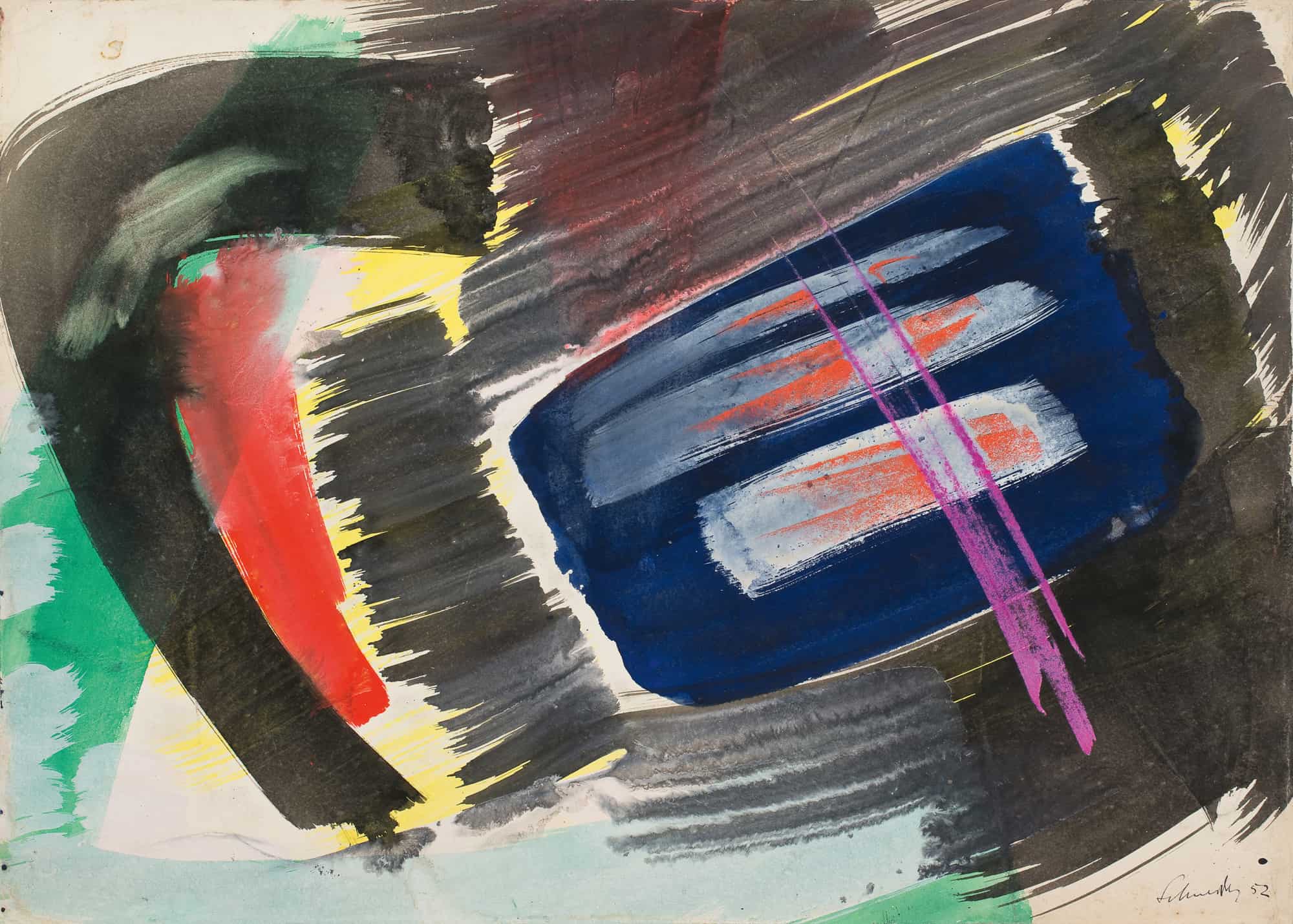
61 – Untitled (double sided artwork), 1952
37,5 x 52,5 cm / 14 3/4 x 20 11/16 in.
Gouache, India ink and pastel on paper
Signed and dated lower right: “Schneider 52”
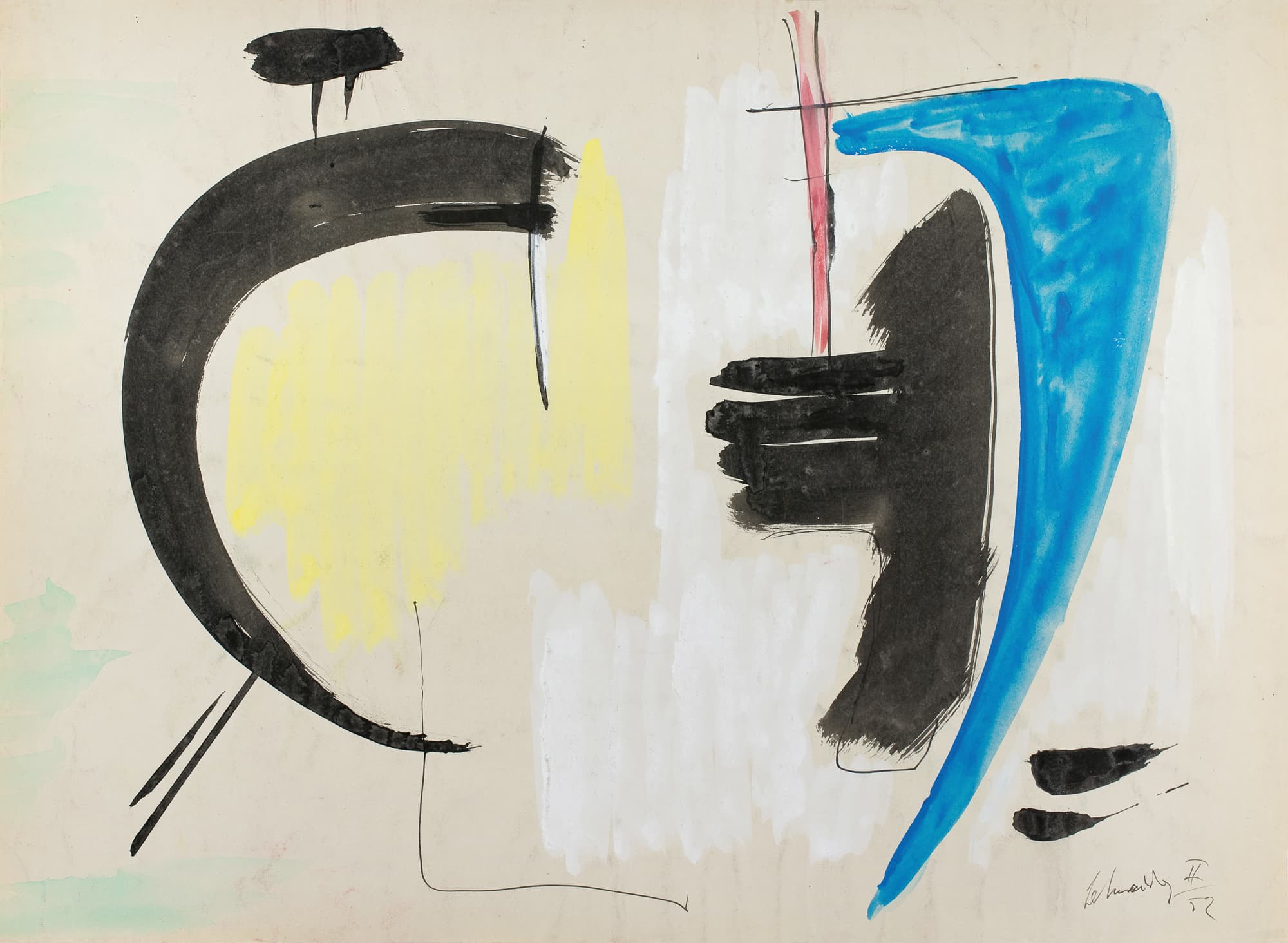
62 – Untitled, 1952
45,7 x 64 cm / 18 x 25 3/16 in.
Gouache, India ink and pastel on paper
Signed lower right: “Schneider II / 52”
Referenced on the back
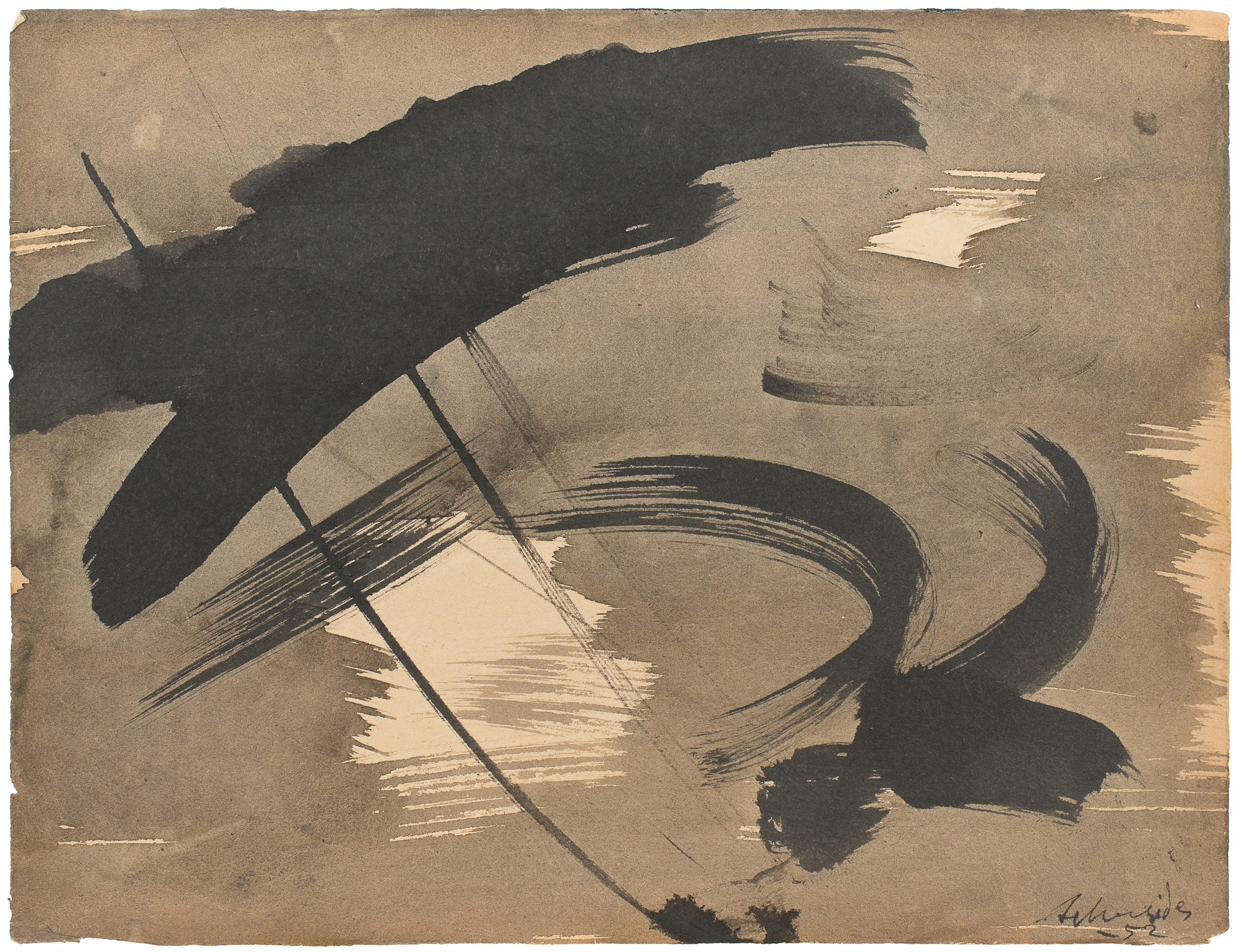
63 – Untitled, 1952
25 x 32,6 cm / 9 13/16 x 12 13/16 in.
India ink on paper
Signed and dated lower right: “Schneider / –52”
Referenced on the back

64 – Untitled, 1952 ca.
11 x 16 cm / 4 5/16 x 6 5/16 in.
Gouache, India ink and pastel on paper
Unsigned and undated. Referenced on the back
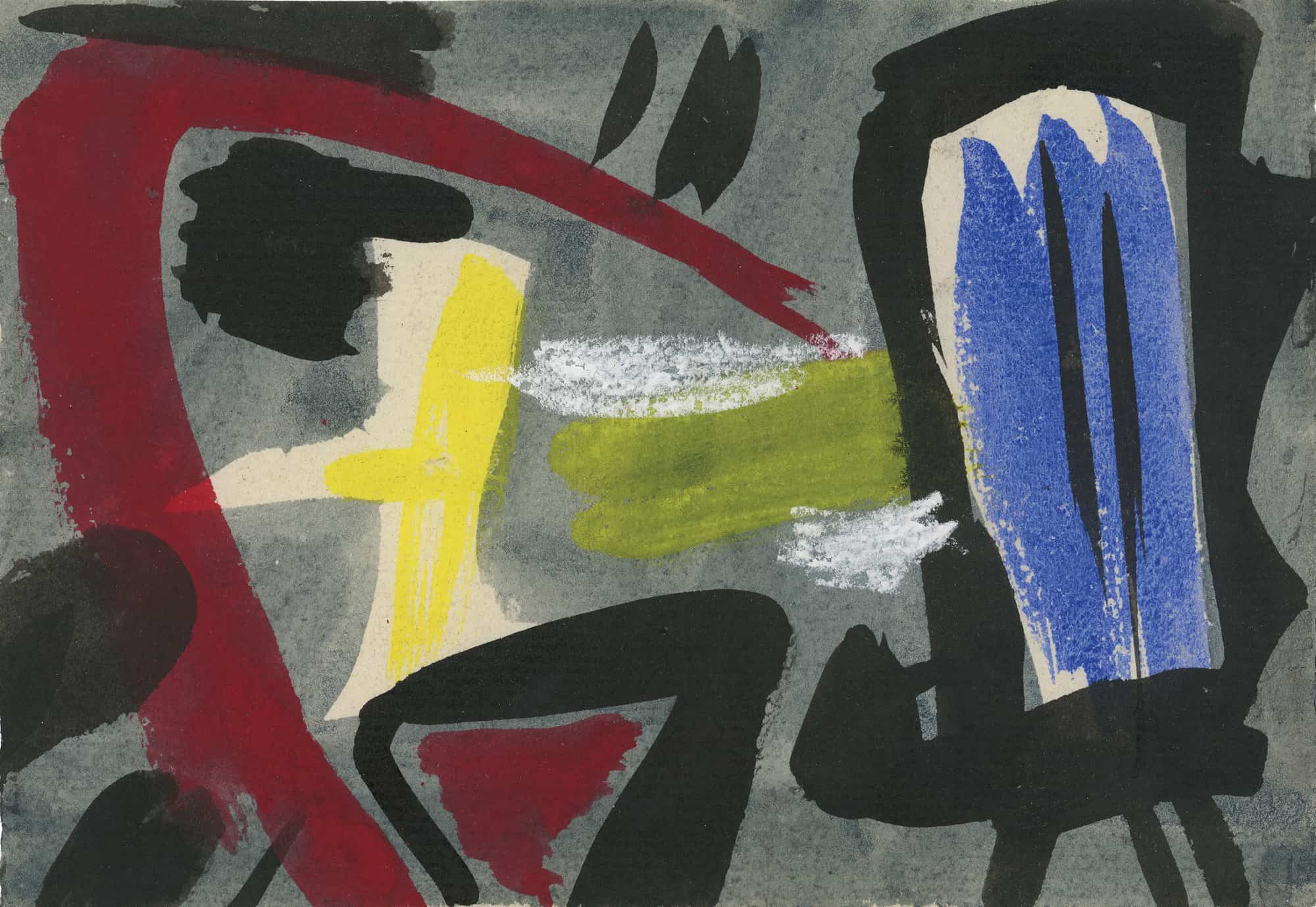
65 – Untitled, 1952 ca.
11 x 16 cm / 4 5/16 x 6 5/16 in.
Gouache, India ink and pastel on paper
Unsigned and undated. Referenced on the back

66 – Untitled, 1954
49,7 x 64,7 cm / 19 9/16 x 25 1/2 in.
Gouache and India ink on paper
Signed and dated lower right: “Schneider / – 5-54 -”
Referenced on the back

67 – Untitled, 1954 ca.
10 x 12,5 cm / 3 15/16 x 4 15/16 in.
Gouache, India ink and pastel on paper
Unsigned and undated
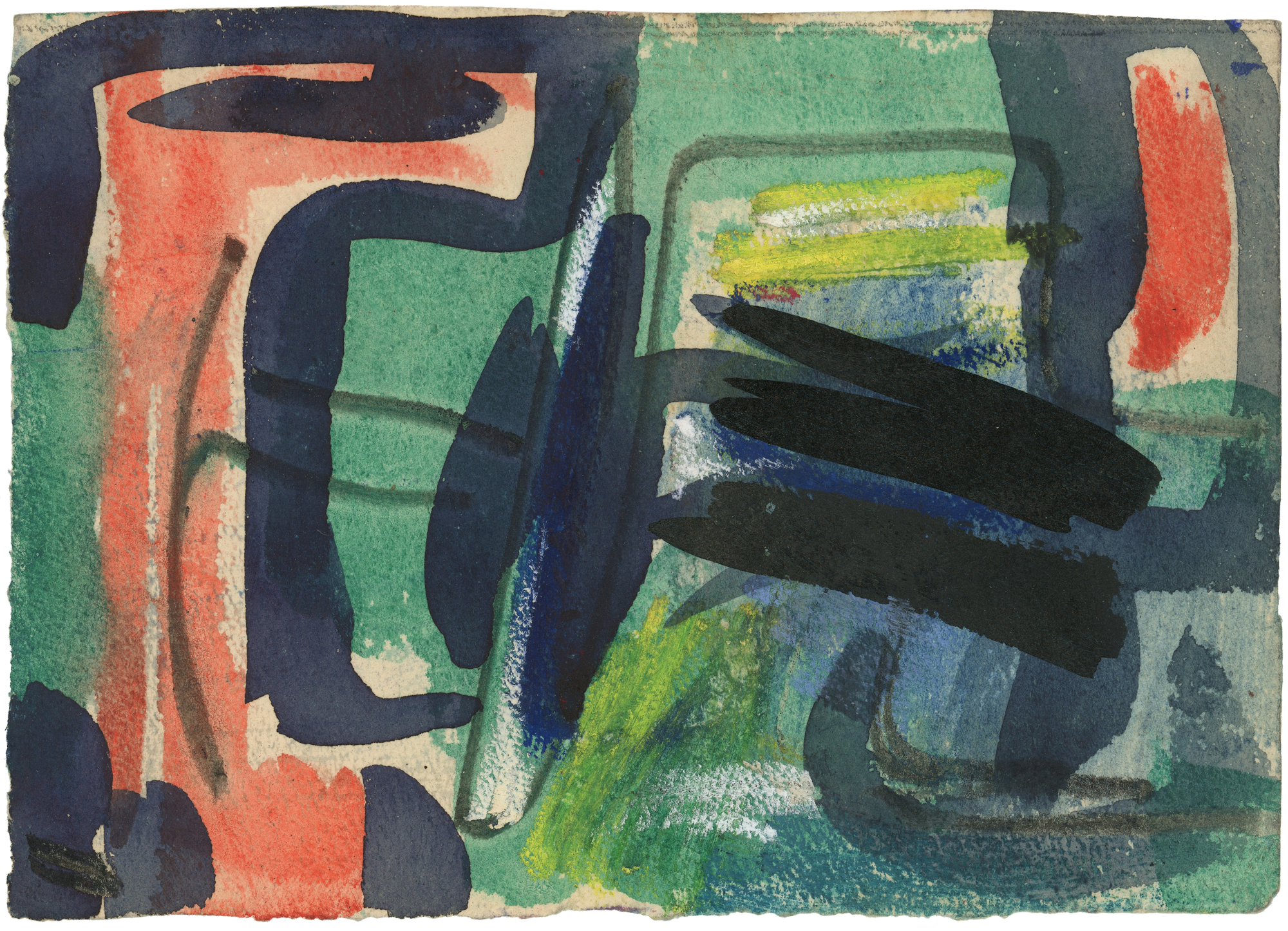
68 – Untitled, 1954 ca.
12 x 17 cm / 4 3/4 x 6 11/16 in.
Gouache, India ink and pastel on paper
Unsigned and undated. Referenced on the back
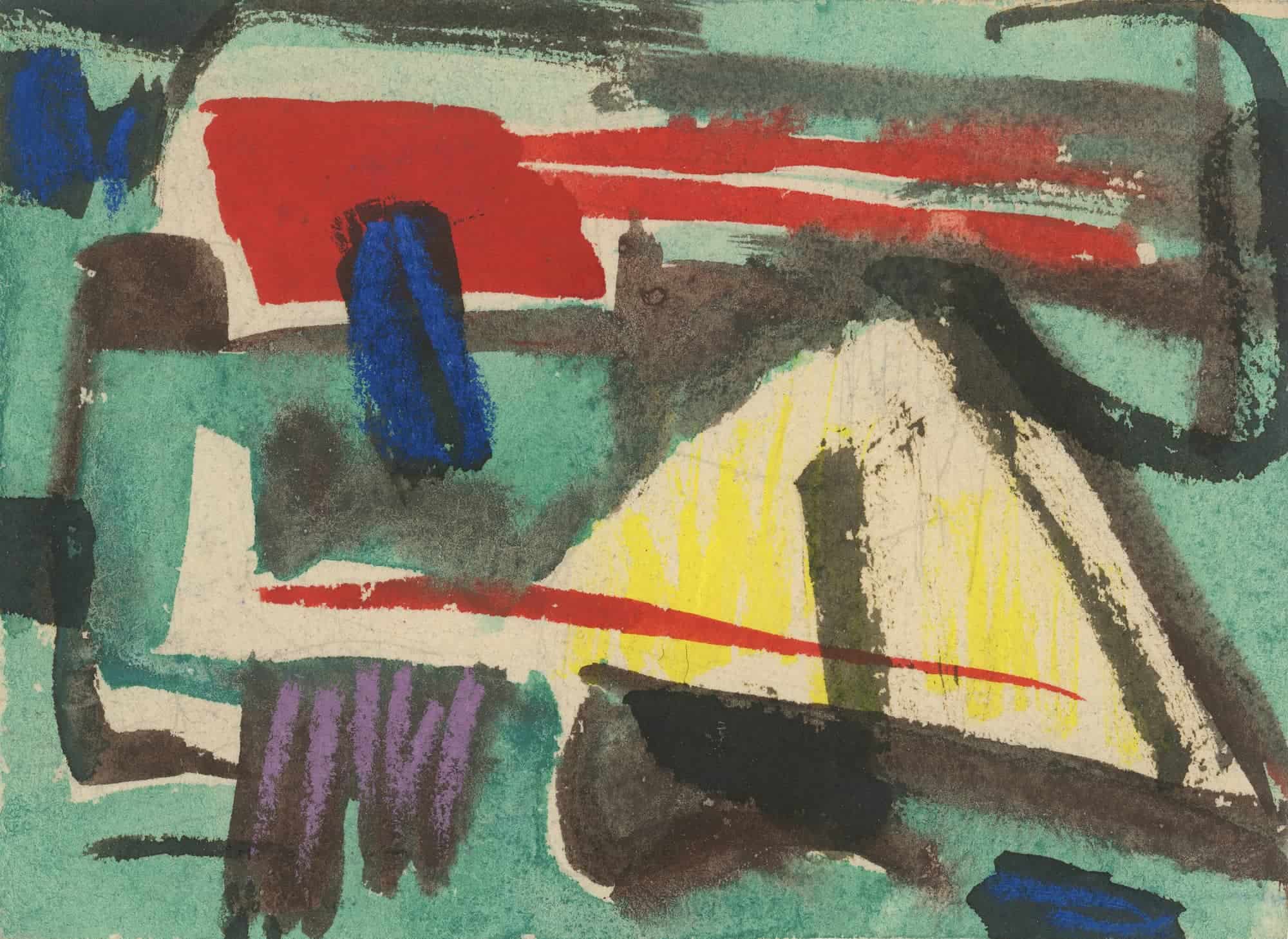
69 – Untitled, 1954 ca.
9,2 x 12,5 cm / 3 5/8 x 4 15/16 in.
Gouache, India ink and pastel on paper
Unsigned and undated. Referenced on the back

70 – Untitled (double sided artwork), 1954 ca.
12 x 17 cm / 4 3/4 x 6 11/16 in.
Gouache, India ink and pastel on paper
Unsigned and undated. Referenced on the back

71 – Untitled, 1955 ca.
13,5 x 20,8 cm / 5 5/16 x 8 3/16 in.
India ink on paper
Unsigned and undated. Referenced on the back
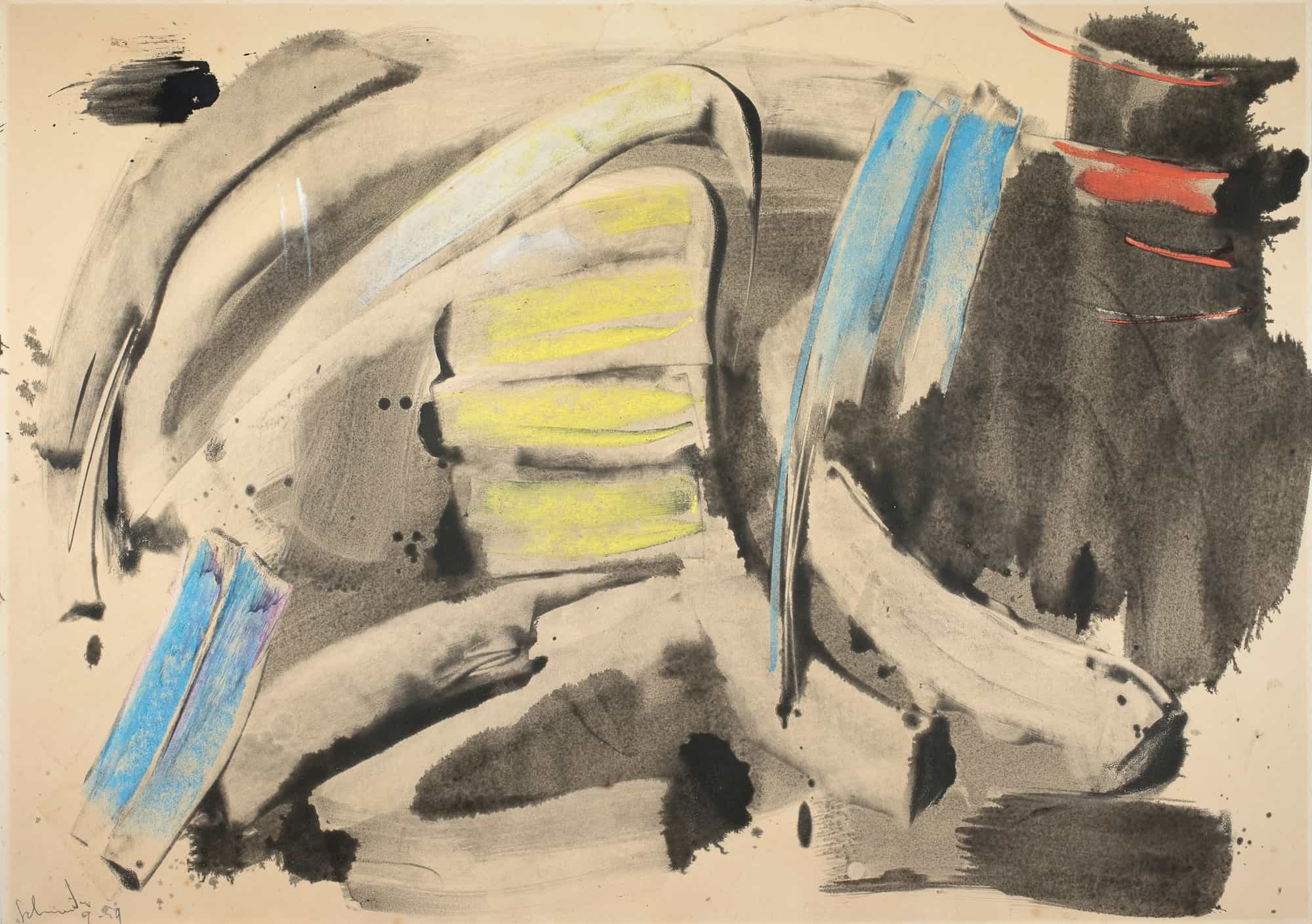
72 – Untitled, 1959
52,7 x 74,3 cm / 20 3/4 x 29 1/4 in.
India ink and pastel on paper
Signed and dated lower left: “Schneider / 9-59”
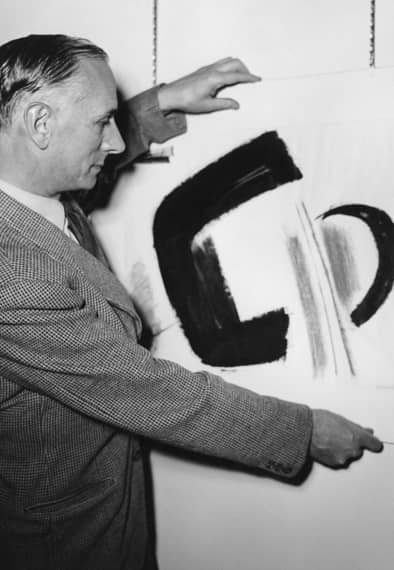
Portrait of Gérard Schneider at the Otto Stangl Gallery, Munich, Germany, 1952
Photograph: Georg Schödl © Reserved rights / Archives Gérard Schneider
BIOGRAPHY
Gérard Schneider was born in Sainte-Croix in Switzerland in 1896. He spent his childhood in Neuchâtel where his father was a cabinetmaker and antique dealer.
At the age of 20, he went to Paris to study at the École nationale des arts décoratifs, and then in 1918 entered the studio of Fernand Cormon at the École Nationale des Beaux Arts de Paris. Cormon had also taught Vincent van Gogh and Henri de Toulouse-Lautrec.
In 1922, Gérard Schneider settled permanently in Paris. The 1920s and 1930s were marked by a long period during which he learned different techniques and the history of painting. In 1926, he exhibited for the first time at the Salon d’Automne. The work he showed, L’Allée hippique (Horse Pathway), attracted attention. He also frequented musical circles in Paris. He exhibited five paintings, including Figures dans un jardin (Figures in a Garden) at the Salon des Surindépendants of 1936, which were appreciated by the critic of La Revue Moderne: “a style, figures of such agility that the expression of movement seems to have been included in the rapid technique”.
He also discovered the artistic movements of the century of upheavals and tragedies during this period. In the mid-1930s, Gérard Schneider assimilated the revolution initiated by Kandinsky’s abstraction, while also exploring the new horizons introduced by Surrealism. He no longer painted from reality. His palette darkened, black now occupied an important position and formed structures. He wrote poems and frequented the Surrealists: Luis Fernandez, Oscar Dominguez, Paul Éluard and Georges Hugnet.
From 1938, the titles of his paintings no longer referred to reality: the three sent to the Salon des Surindépendants were called Composition. In 1939, he met Picasso. Around 1944, his painting definitively abandoned all references to reality.
In 1945, the Musée National d’Art Moderne bought one of his paintings (Composition, 1944).
In the effervescence of the immediate post-war period, Gérard Schneider’s art played a pioneering role in the birth of a new form of abstraction. In Paris, he and other precursors proposed a return to the radicality of abstraction, a form of abstraction that no longer had any connection with the real and perceptible world and would become a landmark, it matched the aesthetic imperatives of this transitional period: it was called Lyrical Abstraction.
Alongside artists such as Jean-Michel Atlan, André Lanskoy, Georges Mathieu and especially Hans Hartung and Pierre Soulages with whom he formed sincere friendships, Gérard Schneider very quickly saw his work acquire an international dimension. From the mid-1940s, major exhibitions grouping the main members of lyrical abstraction were organized in Paris, especially at the galleries of Lydia Conti and Denise René.
Abroad, at major travelling exhibitions, the public discovered this vital creative momentum: around Germany from the late 1940s: this was the exhibition Wanderausstellung Französischer Abstrakter Malerei which circulated throughout West Germany between 1948 and 1949. Schneider’s works were exhibited immediately afterwards in the USA: at the Betty Parsons Gallery (in 1949 and 1951) and in the major travelling exhibition Advancing French Art that was shown all over the country, from Chicago to San Francisco.
Between 1955 and 1961, the Samuel Kootz Gallery in New York was his exclusive dealer in the USA and his representative there. Gérard Schneider joined his friend Pierre Soulages in this prestigious gallery.
The Phillips Gallery of Washington bought Opus 445 of 1950 and New York’s MoMA bought Opus 95B of 1955.
In 1956, he married for the second time. His wife was Loïs Frederick a young American woman who had come to Paris to study art on a Fulbright scholarship, whom he met through Marcel Brion. Around the same time, Schneider met Eugène Ionesco.
Exhibitions were held successively around the world. From the early 1950s, his works were exhibited in Europe: for example in Brussels where there was a first retrospective in 1953, then a second one in 1962 in association with the Dusseldorf Kunstverein. He also participated in the first two editions of Documenta in Kassel in 1955 and 1959.
He exhibited three times at the Venice Biennale, in 1948, 1954 and 1966.
In 1957, he won the Prix Lissone.
His works also travelled regularly, to Japan from 1950 until the early 1970s, especially for the International Exposition of Art. In addition, for the International Art Exhibition in Tokyo in 1950, he was awarded the prize of the Governor of Tokyo.
He also showed several times at the São Paulo Biennale: in 1951, 1953 and 1961. During the 1961 edition, Jean Cassou, chief curator of the Musée National d’Art Moderne de Paris, asked Schneider to create four canvas paintings 2 x 3 m for a group of ten large format works that were exhibited.
During the 1960s, he maintained a close connection with the Milan-based dealer, Bruno Lorenzelli who held many exhibitions of his work around Italy. This decade of change saw Schneider’s painting acquiring more color, becoming freer while the gesture acquired a definitively calligraphic dimension.
Yet again, Schneider’s work evolved and echoed the aestheticaspirations of his time as much as a complex interior process that had begun many years earlier. A synthesis of the notions of form, color and space.
At the 1966 Venice Biennale, an entire room of the French Pavilion was devoted to his work.
Similarly, a major retrospective was held of his work in Turin in 1970 where about a hundred paintings were exhibited at the Galleria civica d’Arte Moderna. This was a great success, and then the exhibition continued at the Terre des Hommes Pavilion in Montreal.
At over 70, his art continued its effervescence. The fire was still as intense. The volcanic eruption of color more fervent than ever, as if his work was destined never to be extinguished.
Exhibitions continued at the same pace, such as those held by the Galerie Beaubourg in Paris.
This fire, this energy, required a speed of execution that only paper seemed to allow. At the start of the 1980s, he turned towards this support almost exclusively. This is how, in the intimacy of his studio, large and luminous compositions full of color were born, enflamed, the unreal beauty of which continue to fascinate.
Gérard Schneider left this world on 8 July 1986 at the age of 90 and bequeathed us an oeuvre that was both simultaneously unfathomable in its aesthetic complexity and yet so close, so human and so sensitive.
Today his works are on view in the most important museums such as MoMA in New York, the Phillips Collection in Washington, the Walker Art Center of Minneapolis, the Montreal Museum of Fine Arts, the Museum of Fine Arts of Seoul, Brussels Museum of Modern Art, the GAM of Turin, Galleria d’Arte Moderna, Milan, the Kunsthaus in Zurich and the Centre Pompidou in Paris.
In 1998, Michel Ragon published a major monograph on his work.
In 2021, the Galerie Diane de Polignac will publish the Catalogue Raisonné of the Paintings of Gérard Schneider.
MAJOR COLLECTIONS
Brussels, Musée Modern Museum
Buffalo, Albright-Knox Art Gallery
Cologne, Ludwig Museum
Colorado Springs, Co, Fine Art Center
Dunkirk, LAAC
Geneva, Fondation Gandur pour l’Art
Jakarta, Museum
Kamakura (Japan), Museum of State
Los Angeles, Ca, University of California
Milan, Museo d’Arte moderna
Minneapolis, Mn, Walker Art Center
Nantes, Musée d’Arts
Neuchâtel (Switzerland), Musée d’Art et d’Histoire
New Haven, Ct, Yale University
New York, NY, Museum of Modern Art (MoMA)
Oslo, Sonja Henie and Niels Onstad Foundation
Paris, Musée d’Art Moderne de Paris
Paris, Musée national d’Art Moderne – Centre Pompidou
Phoenix, Az, Phoenix Museum
Princeton, Ma, Princeton University
Rome, Galleria d’Arte Moderna
Rio de Janeiro, Museu de Arta Moderna do Rio de Janeiro
Saint-Louis, Mo, Washington University
Seoul, Fine Art museum
Turin, Galleria civica d’Arte Moderna
Washington D.C., The Phillips Collection
Worchester, Ma, Worchester Museum
Zurich, Kunsthaus
MAJOR EXHIBITIONS
Denise René Gallery, Paris, 1946, 1947, 1948, 1953
Lydia Conti Gallery, Paris, 1947, 1948, 1950
Biennale of Venice, 1948, 1954, 1966
Wanderausstellung Französischer Abstrakter Malerei, traveling group exhibition in the Federal Republic of Germany: Stuttgart, Munich, Dusseldorf, Hanover, Hamburg, Frankfurt am Main, Freiburg im Breisgau, 1948-1949
Betty Parsons Gallery, New York, 1949, 1951
Les grands courants de la peinture contemporaine (de Manet à nos jours), traveling group exhibition in South America, 1949-1950
Advancing French Art, traveling group exhibition in the USA: Louisville, Bloomington, San Francisco, Chicago and Washington, 1951-1952
Biennale of São Paulo, 1951, 1954, 1961
Der Spiegel Gallery, Cologne, 1952, 1953, 1955, 1957, 1981
Otto Stangl Gallery, Munich, 1952
International Art Exhibition, traveling group exhibition in Japan, 1953-1965
Rétrospective, Palais des Beaux-Arts, Brussels, 1953
Arnaud Gallery, Paris, 1954, 1959, 1965, 1967, 1968, 1970
Documenta, Kassel, 1955, 1959
Kootz Gallery, New York, 1956-1961
Apollinaire Gallery, Milan, 1958
Albright-Knox Art Gallery, Buffalo, NY, 1958, 1959, 1966, 1972
Lorenzelli Gallery, Milan, 1960, 1961, 1965, 1972, 1974, 1986, 1989, 2012
Minami Gallery, Tokyo, 1960
Nakanoshima Gallery, Osaka, 1960
Im Erker Gallery, St. Gallen, 1961, 1963
Salon de Mai au Japon, Tokyo, Osaka, 1962
Rétrospective, travelling exhibition : Kunstverein, Dusseldorf / Palais des Beaux-Arts, Brussels, 1962
Paintings in France 1900-1967, travelling group exhibition in the USA: New York, Boston, Chicago, San Francisco and in Canada, 1968
Rétrospective, Galleria civica d’Arte moderna, Turin / Pavillon Terre des Hommes, Montreal, 1970
Panorama de l’Art contemporain, travelling group exhibition in Iran, Egypt, Greece, Turkey, Syria, Morocco, Algeria, Tunisia, Lebanon, 1971-1972
Beaubourg Gallery, Paris, 1974, 1975, 1977, 1981, 1986
Rétrospective, Art and History Museum, Neuchâtel / Contemporary Art Museum, Dunkirk, 1983
FIAC, Patrice Trigano Gallery, Paris, 1983
Kunstmesse, Basel, 1985
L’Europe des grands maîtres, Musée Jacquemart-André, Paris / Musée des beaux-arts, Seoul, 1989
Schneider, rétrospective, Clermont-Ferrand, Carcassonne, Montbéliard, Le Mans, Metz, 1998-2001
L’Envolée lyrique, Paris 1945-1956, Musée du Luxembourg, Paris, 2006
Gérard Schneider, grands gestes pour un grand monde, Art and History Museum, Neuchâtel, 2011
Montparnasse / Saint-Germain-des-Prés, Angers / Bordeaux, 2012
Les Sujets de l’abstraction, Peinture non-figurative de la Seconde École de Paris (1946-1962), group exhibition, Fondation Gandur pour l’Art, Musée Rath, Genève / Musée Fabre, Montpellier, 2011
Gérard Schneider, rétrospective, Musée des Beaux-Arts of Orleans, 2013
Le Geste et la Matière – Une abstraction « autre » – Paris, 1945-1965,
Fondation Clément, Le François, Martinique, 2017
GÉRARD SCHNEIDER
The Emergence of Gesture
Works on paper – 1944-1959
Exhibition from November 5 to December 18, 2020
Galerie Diane de Polignac
2 bis, rue de Gribeauval – 75007 Paris
www.dianedepolignac.com
Translation: Jane Mc Avock
Printed in France
© Works of Gérard Schneider: ADAGP, Paris, 2020
Photographs of the Works: Reserved rights
© Galerie Diane de Polignac, 2020
